new posts in all blogs
Viewing: Blog Posts Tagged with: atheists, Most Recent at Top [Help]
Results 1 - 21 of 21
How to use this Page
You are viewing the most recent posts tagged with the words: atheists in the JacketFlap blog reader. What is a tag? Think of a tag as a keyword or category label. Tags can both help you find posts on JacketFlap.com as well as provide an easy way for you to "remember" and classify posts for later recall. Try adding a tag yourself by clicking "Add a tag" below a post's header. Scroll down through the list of Recent Posts in the left column and click on a post title that sounds interesting. You can view all posts from a specific blog by clicking the Blog name in the right column, or you can click a 'More Posts from this Blog' link in any individual post.
Review: Martin Limón. The Iron Sickle. NY: Soho Press, 2014.
ISBN: 9781616953911
Guided serendipity led me to find a Martin Limón novel on the new books shelf of the library and in a flash I realized I hadn't seen a Sueño and Bascom novel in a while. Turns out I've missed two since enjoying 2009's G.I. Bones. Finding The Iron Sickle went ahead and made my day.
Reading a Sueño and Bascom crime novel comes with everything, and more, readers find in the best cop novels: Intriguing setting, local color, irrepressible heroes, insurmountable odds, ingenious plotting. The add-ons include an outcast Chicano detective, Korea, and the U.S. Army in the 1970s.
Martin Limón weaves all the elements together in
The Iron Sickle, latest novel in the long-lived cop series. One needn’t have read other titles to enjoy everything
The Iron Sickle offers, but Limón consistently alludes to events happening in earlier novels, head-turning, momentous stuff, dropped into a paragraph in passing. Limón gives a reader plenty of motivation to seek other titles in the series.
The Korea and Army setting will be completely foreign to all but a tiny fraction of U.S. readers. This makes the author responsible for a lot of explaining about language, culture, and attitudes, both Korean and Army. Limón uses that as a way to enrich the novels with fascinating local color and military slang.
George Sueño is the only Chicano in the novels, so his East LA background is noted only spottily in the series—he has no contemporaries at work, no one to talk to, so it doesn’t come up. Such is the life of being “the only one.” Plus, he’s a cop. But Limón isn’t glorifying cops shooting U.S. civilians. The cops in
The Iron Sickle battle the Army as much as criminals.
In the novel, it’s been twenty years that events spun out of control on a remote mountainside during war, launching a murder spree for revenge and ruining lives. Sickled necks and a butchered rat lead the CID agents to a remote commo site in the middle of nowhere to discover a morally ambiguous criminality.
Bilingualism singles out the agent for going against the Army’s monolingual grain. In series novels, he speaks a little Spanish, but that’s not the issue. Sueño is the only CID agent in country who speaks and reads Hangul. Knowing the language inevitably leads to cracking the case while providing interesting insights into local language and culture. It’s also a signal that Sueño not only is a lifer, he’s addicted to Korea. Sueño’s so alienated from The World, as overseas GIs call the US, he’s never coming home.
Military culture puts obstacles in the investigation’s path. Hardheaded Officers and Senior NCOs follow the Army way which is uniformity and chain of command. Sueño and Bascom hold that in contempt and are the opposite of STRAC troopers expected of high headquarters minions.
Their results make them immune to all but spite, no matter how wild and impetuously the detectives act. Limón gives them lots of ways to act up; Bascom, a ville rat and short-fused jerk, Sueño, the oddball who thinks too much and hooks up with the wrong woman. When Sueño’s thinking too much he misses clues or gets his ass kicked.
When the boss or some general gets a case of the ass, the pair catch their ration of shit details, like arresting housewives for buying too many toothpastes. What really irks the chain of command is having the Koreans request Sueño and Bascom work a case.
Limón tirelessly exposes mindless military rivalry between US forces and local authority. These cops are righting wrongs despite established power, not to further the military’s goals. Solving crime often gives a well-deserved black eye to military politics. Higher ups prefer to keep matters quiet and tidy. Sueño and Bascom are loud and unruly, and that’s only half the fun of reading a Sueño and Bascom mystery.
The Iron Sickle treads on forbidden territory, cannibalism. While fiction can take readers into the most perverse territory, it won’t stop them from getting queasy at the horror of the crime, the imperative of revenge, and the unasked question, “how many wrongs make a right?”
The Iron Sickle is a great companion for a winter read. Curling up next to a fire and whiling away the hours until 2015 might be just the ticket for mystery readers with a hankering for off-the-wall travel writing.
 |
| Korean farmer at DMZ 1970. foto:msedano |
La Palabra Has Last WordGente crowd into the main gallery at Northeast Los Angeles' Avenue 50 Studio. Here for the final La Palabra reading of 2014, the prospect of hearing three of the city's most distinctive poetic voices draws them in well after the Open Mic is underway. Late-arrivers line up against the wall between the art or step gingerly into the space between the circled chairs to sit on the floor. SRO means "sitting room only" for Poet Laureate Luis J Rodriguez and friends Peter J Harris and Hector Flores.
Today's reading culminates the first year of emcee Karineh Mahdessian's service organizing the monthly series.
La Palabra at Avenue 50 Studio has enjoyed a thirteen-year run showcasing high calibre art and engaging an Open Mic poetry community nurtured by the social churn of working class eastside L.A.
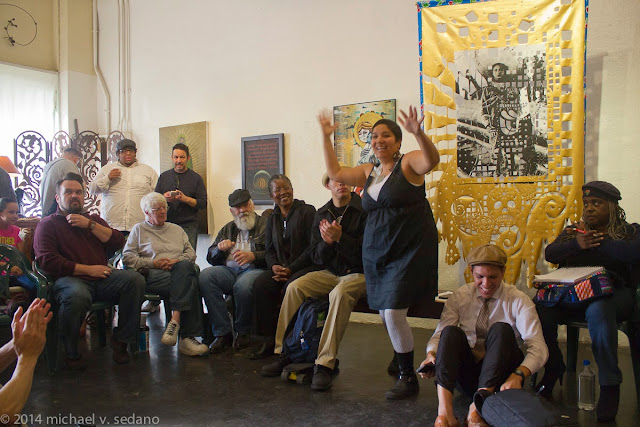 |
Karineh Mahdessian |
Mahdessian's high spirits spark the already energized crowd as she gets the Open Mic started. The day offers wonderful examples of the "community" in "poetry community." Visitors today include people from Arizona and the U.S. midwest. One reader is making her debut in front of an audience today. People exchange abrazos and introduce new friends.
The first speaker doesn't read. He's a social scientist with a book and rambles for awkward minutes before audience members interrupt him with applause. He's reluctant to finish but the relieved Mahdessian steps in and the fellow fills his chair. The presentation offers one of the awful moments in an emcee's role, how to use the hook.
 |
| Rudy Calderón |
Rudy Calderón works from memory, in Spanish and in rhyme. The packed house and floor eliminate the lectern and lets speakers choose reading in situ or using the constricted bit of open space.
Calderón stands and projects with excellent resonance. There's so much energy in his body aching to break loose if allowed a stage. He controls it well and redirects much of that energy into the reading.
 |
| C.E. Jordan |
C. E. Jordan is the fourth poet after Calderón. Jordan stands in place to share a holiday piece that makes an appreciated change-of-pace. That microphone is ironic because Jordan projects sonorously with crystal clear enunciation that serves her words well. One reader uses the mic and it doesn't go over well. No reader uses the mic again.
 |
| Juan Carlos Valadez |
Juan Carlos Valadez follows Jordan in one of those change-of-pace presentations that keep audiences coming back to La Palabra.
Mahdessian announces the next reader. From his chair, Valadez introduces his wife and daughter. He walks into the open space, and asks the teenager's permission to read a poem letter he wrote her from prison.
 |
| Rosalio Muñoz |
Rosalio Muñoz is the final Open Mic reader. He selects a few paragraphs from the Laguna Park section of
Stella Pope Duarte's movimiento novel,
Let Their Spirits Dance. Muñoz is sitting next to me so I point and shoot hoping for a good moment. This is approximately the perspective the crowd had of Rosalio up on the podium that day in Laguna Park.
Muñoz is the final name signed to the Open Mic. A number of poets have asked for a slot so Mahdessian announces a second Open Mic after the three featured readers.
The featured poets have conferred and adapted to the setting and audience. Rather than do three stand-ups, Hector Flores, Peter J. Harris, and Luis J. Rodriguez will do a round-robin. Harris goes first.
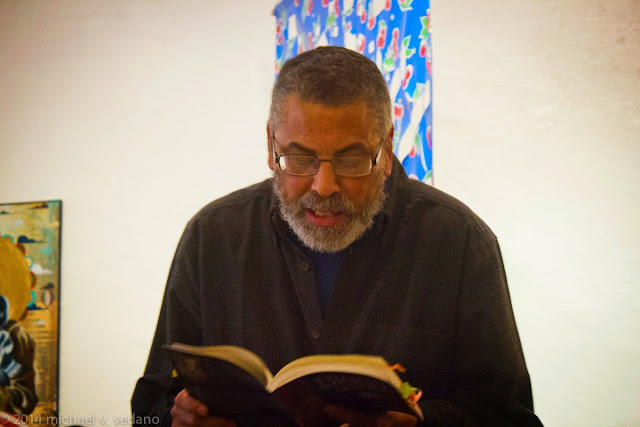 |
| Peter J. Harris |
The round-robin is a wonderful way to treat an audience. People universally appreciate variety, whether within a single poem or a set. The three featured writers each performs with unique voice and distinctive style. Harris and Flores read so deeply moved by their own emotions that their words come out as heartfelt music.
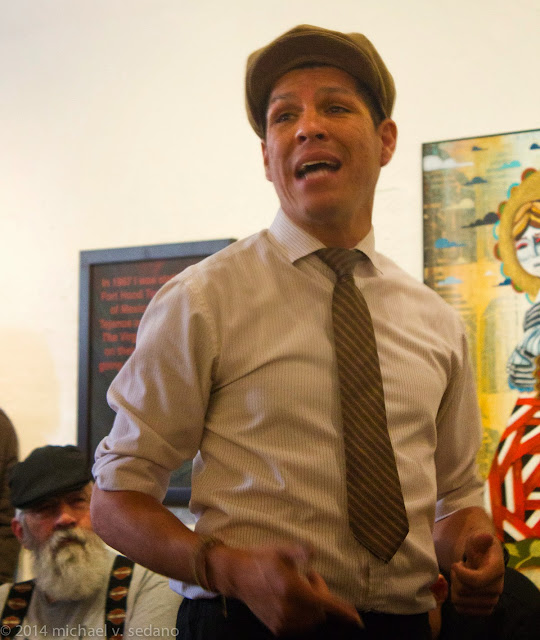 |
| Hector Flores |
 |
| Hector Flores |
Luis J. Rodriguez greets his audience today as a proud father, local poet, and Poet Laureate of Los Angeles. The Laureate vows to infuse LA with poetry during his tenure, though the exact program remains in development. Today's reading signals an important development.
It's not that Luis forgot his stuff back at the house and will read old stuff. Rodriguez' good stuff is timeless and he keeps working on them, if not in the craft in the performance.
Rodriguez has rarely read these poems with the kind of sustained energy he displays in the packed space today.
He's loud, he's angry, he's emotional, ya se cansó. Thoughts and emotions in words come out in his arms, eyes, brow, posture. He fills the space allowed. He reads today focused on content over form, breaking at thoughts instead of lines.
Media aren't the Laureate's friend today. One poem comes from an orange quarter-fold booklet, another from a telephone screen, two from a book. He needs his anteojos, plus he's getting off the floor every third reader.
Rodriguez, like Harris, works to personalize the reading through eye contact. Reliant upon their text, it's sparse and momentary. Their work has enough power that audiences don't miss what they're not getting. But because these poets could do these poems from memory without the prop, there's a lost opportunity to magnify their audience's enjoyment of the work.
 |
| Luis J. Rodriguez |
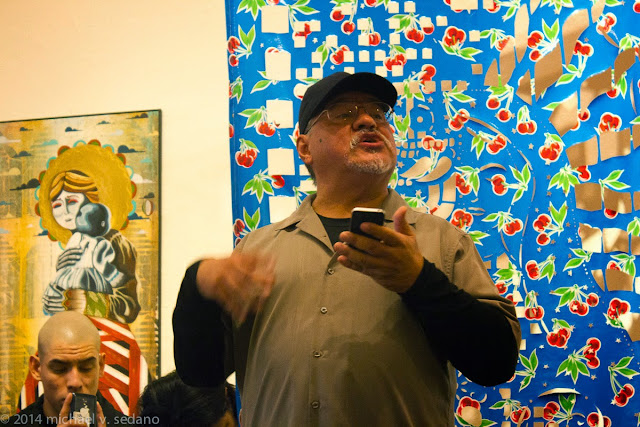 |
| Luis J. Rodriguez |
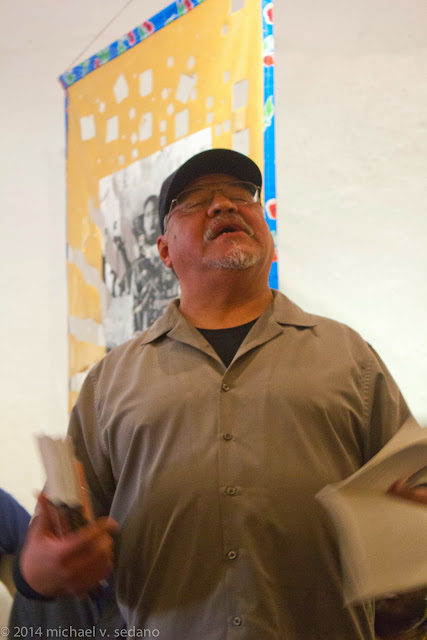 |
| Luis J. Rodriguez |
The Gluten-free ChicanoGood Mexican Girl Hits the SpotEarlier in December, The Gluten-free Chicano sat around feeling sorry for himself that gluten-free analogs are crummy and he needed a snack. The Gluten-free Chicano, in a fit of antoja, wrote about a gluten-free bakery that sounded like it would hit the spot, the
Good Mexican Girl's cookies.
The Good Mexican Girl herself took the column as a challenge, to get some of her cookies to The Gluten-free Chicano. She did it. And he's glad.
GMG gluten-free Mexican Wedding Cookies aren't quite the powdery puro butter and wheat flour nuggets of yesteryear, but GMG Mexican Wedding Cookies are number hana, as they say in Korea, number one.
They hit the spot.
GMG discovered the secret to a velvety texture on the tongue. Other GF treats have a raspy grit to them like 440 sandpaper on the tongue. Yuck. Bite into the crumbly texture of a GMG Mexican Wedding Cookie and all the flavor and a pleasing tooth greet one. Savor it and allow the crumbs to work their magic. Smooth all the way down. Next: GMG chocolate chip cookies.
¡Ajua! Good Mexican Girl. Te aventastes.
Late-breaking News!https://www.facebook.com/events/484993604975550/Click link to get your tickets.Floricanto for Michele Serros Sunday, January 4, 2015at 6:00pm
Alumni House, UC Berkeley
1 Alumni House, Berkeley, California 94720
La Bloga encourages readers to purchase tickets to support Michele Serros' challenges during her health crisis. Gente in the Bay area will want to appear in-person for this important event. Here is the latest organizer report.
Hosts/MCs: Joseph Rios- friend of Michele and poet
Jennie Luna- friend and Cal State Professor of Xican@ studies at Cal State Channel Islands
Readers/Friends of Michele: Melinda Palacio- author and friend
Joe Loya- author and friend
Cindy Cruz- close friend of Michele and professor of education at UCSC
Alberto Ledesma- friend, UC Berkeley professor and DREAM artivista
Silent Auction at the event with works by: Malaquias Montoya
Maceo Montoya
Melanie Cervantes
Mitsy Avila Ovalles
Santos Shelton
Lalo Alcaraz
Ester Hernandez
Jessica Sabogal
Signed vinyl records from the band, Chicano Batman
Michael Sedano
On November 24 La Bloga-Tuesday published an advance review of “Skin In The Game” without acknowledging the previous day’s announcement in Ferguson, despite jarringly ugly disconnects between reality and fiction.
Sabrina Vourvoulias remarks in her blog, Following the lede, how she feared a pro-cop sci-fi story she wrote might do harm since it would be published a day after the cop who murdered Michael Brown exited stage right, unindicted.
“Skin In The Game” features chicana detective Jimena Villagran, who strides into the heart of Philadelphia’s most dangerous neighborhoods where something is killing people, ripping them open and eating their organs. “Skin’s” dystopic Philadelphia uncomfortably mirrors the city's neighborhoods. Vourvoulias' journalistic eye further enhances the verisimilitude, the kind that gives good sci-fi its unnerving metaphors.
Both author Vourvoulias and publisher Tor worried that glorifying a monster-fightiing cop hero could damage people already tortured by the failure of process. “Skin In The Game” was to be published on December 2, a week following the November 24th announcement in Ferguson.
Vourvoulias believes words take on a life of their own, that people invest stories with meaning beyond the writer’s influence. She didn’t want her story of a good cop fearlessly fighting for Order and the Good to give a punch in the face to a reader working to make sense of systemic perversions of Justice.
“Skin In The Game” published on schedule, December 2, 2014, because, the editor reasoned, there might never be a week free from news of “hideous injustice”. Was that prescience, or experience?
The day following Tor.com’s publication of "Skin In The Game", New York found no reason to indict the cop in the choke hold murder of Eric Garner. But then, that’s a standard Unitedstatesian value: one hundred fifty years ago, Congress declared the November 29 Sand Creek Massacre an atrocity but allowed the commander to walk away unindicted.
Vourvoulias and her publisher resolved their concerns and published despite the clear contradictions between the fiction and the world as we have it. Similarly, La Bloga’s critical response to this work of art limited itself to the self-contained universe of the fiction.
The open issue screams out loud. Cops are not heroes, why does literature glorify them? Is it harmful to a reader to be rooting for the “good” detective to win when every day news abounds with one dead reason after another to distrust cops?
Persuasion research shows that people are drawn toward favorability of dissonant messages when an admired person advocates for the other side. The latitudes of attitude move away from favorability to the source, but toward favoring the issue. That’s in ordinary persuasion, like politics. Fiction can be perniciously influential. Could it be detective fiction is poisoning the common sense and survivability of a person confronted by a trembling cop with a Glock?
Leave a Comment to share your views. You’ll find the Comments link at the bottom of today’s column.
The Gluten-free Chicano
What’s a Good Mexican Girl To Do?

The Gluten-free Chicano has a sweet tooth. Cookies, pies, birthday cakes, conchas, helotes, marranos, polvorones, are all off-limits to Celiacs and others afflicted by gluten intolerance.
Analogs look like edible food but only in one's imagination they're good. Now, poet reina alejandra prado has found what appears to be a productive way to indulge a Celiac's sweet tooth. Prado is the
Good Mexican Girl in the eponymous bakery.
Click the
link to visit the Good Mexican Girl, an artisanal bakery specializing in unique flavor profiles, says the website.
GMG's website observes, "The cornerstone of our business is a cookie - the one I call 'throw me a wedding shower' cookie, most popularly known as the Mexican wedding cookie or Russian teacake. It's buttery, nutty and just scrumptious with a hint of lemon and sweetness from the powder sugar. We made the original Gluten Free Mexican Wedding Cookie."
Here's the origins of the GMG's commitment to the Gluten-free community:
"�
Several years ago, I learned about a gluten-free diet first from my friend Maya. She had to change her diet after under going a series of tests. After I underwent a food cleanse where I could not eat any foods prepared with enriched flour or wheat bread, I became more conscious of what is gluten-free. My awareness of the need for gluten-free products became more pronounced with my business. Clients would ask if I had gluten-free options. In November, with the pan de muerto (Day of Dead Bread), I baked our first gluten-free product.
We continued to produce gluten-free treats with the traditional Mexican sweet bread La Rosca de Reyes and with Mexican Wedding Cookies.
It’s been a joy to meet virtually and in person other Latinas who haven’t been able to eat their favorite sweet breads and now can happily enjoy them again in gluten-free form."
The Gluten-free Chicano isn't uncritical about GMG products, especially the claim "We can make any baked good with gluten-free flour. We make our flour blend that includes Rice Flour or Brown Rice Flour, (whichever one is available), Potato Starch, Tapioca Flour, and Xanthum Gum."
"Any" certainly is possible. But as noted, analogs suck, so the Gluten-free Chicano is not ever again buying "bread" or "cake" or "pie crust" made to be gluten-free. The cookies, now that's a different matter.
Full disclosure: The Gluten-free Chicano enjoys Prado's poetry but has yet to taste her cooking. When he finally has the opportunity to scarf down some GF galletas, La Bloga will report the Good Mexican Girl's success. If it's sweet and dunkable, I'm sure I'll like it. I hope I like it. Oh please.
Faltamos 43! On-line FloricantoFrank Acosta, Ivonne Gordon Carrera, Tara Evonne, Victor Avila, Xico González“Warrior Poets Rise (Sovereignty, Justice, Peace)” by Frank Acosta
“AYOTZINAPA” Por Ivonne Gordon Carrera
“Mezcla,” by Tara Evonne
"El Pañuelo Negro" por Victor Avila
"Semillas de Ayotzinapa" by Xico González
Warrior Poets Rise (Sovereignty, Justice, Peace)by Frank AcostaThe stories are blood flowing thru you
Our people’s truth, worthy to be told
In solidarity, set us free to awaken
The strumming of dormant heart-chords
Searching for sacred songs of purpose
Your words are those of the ancestor’s
Spirit voice returning in wisdom
Your offerings of soulful flor y canto
The silenced stanza of a departed child’s poem
Verses of the lost, to violence, ignorance, greed
Tyrannical avarice would still humanity for gold
Shackled deep inside the belly of the beast
Songs, poems, & prayers of the warrior poet
A confluence of hearts, minds, and souls
Flesh & spirit, present & past, one great circle
Let word and deeds flow in transformative love
Sentinels of sovereignty and sanctity of all creation

Frank de Jesus Acosta is principal of Acosta & Associates, a California-based consulting group that specializes in professional support services to public and private social change ventures in the areas of children, youth and family services, violence prevention, community development, and cultural fluency. In 2007, he authored, The History of Barrios Unidos, Cultura Es Cura, Healing Community Violence, published by Arte Publico Press, University of Houston. Acosta is a graduate of University of California, Los Angeles (UCLA). His professional experience includes serving in executive leadership positions with The California Wellness Foundation, the Coalition for Humane Immigration Rights of Los Angeles (CHIRLA), Downtown Immigrant Advocates (DIA), the Center for Community Change, and the UCLA Community Programs Office. He is presently focused on completing the writing and publishing a two book series for Arte Publico Press focused on best practices to improve the well-being of Latino young men and boys. Acosta most recently co-authored a published “Brown Paper” with Jerry Tello of the National Latino Fatherhood and Family Institute (NLFFI) entitled, “Lifting Latinos Up by Their Rootstraps: Moving Beyond Trauma Through a Healing-Informed Framework for Latino Boys and Men.” Acosta provides writing and strategic professional support in research, planning, and development to foundations and community-focused institutions on select initiatives focused on advancing social justice, equity, and pluralism. He is also finalizing writing and editing a book of inter-cultural poetry and spiritual reflections.
AYOTZINAPAPor Ivonne Gordon CarreraAyotzinapa, hace poco no podía pronunciar tu nombre.
Ahora no sólo lo pronuncio, no sólo lo repito,
sino que es una herida abierta en la tierra.
Es una violación de la tierra, 43 hijos
de vientres heridos claman, Ayotzinapa
ya no es una palabra, ya no es un lugar.
Ayotzinapa es un monumento a la violencia,
es un campamento de jardines descompuestos.
Es un grito, un aullido, es cicatriz
y carne viva. Ya basta.
Ya nos cansamos
de tanto ataúd y vitrina.
© Ivonne Gordon Carrera (2014)AYOTZINAPAby Ivonne Gordon CarreraAyotzinapa, not long ago I could not pronounce your name.
Now I pronounce it, now I repeat it,
now it is an open wound of the earth.
The ground has been raped, 43 sons
of wounded wombs cry out. Ayotzinapa,
it is no longer a word, it is no longer a place.
Ayotzinapa is a monument of violence,
It is a camp of decomposed gardens.
It is a yell, a howl, it is a scar
of live flesh. Enough, we have become tired
of caskets and showcases.
© Ivonne Gordon Carrera (2014)Mezcla by Tara EvonneI became
the mix
of all those
before me
las abuelitas
enduring me
de méjico
y españa
my mix
of dark
and light
all I’ve ever
known
to be true
my red heart
beating brown
never did I
believe
mankind
this corazón
migrating
when distraught
a daughter
trusting life
somewhere else
when flying
sideways
I became torn
my parts
fluttering
the effects
of long term
generational genocide
buried under
the rubble
of mankind
all my relations
ancestors
praying alongside
determined
to protect
women and children
I became
the written
poetry
across maps
of great divides
hate created
by mankind
I became
the shooting star
tearing across
early dawn sky
a woman kind
of star dusting
trailing
for others
to follow
the collective
movement
of survival.
Tara Evonne Trudell is a recent graduate with her BFA in Media Arts from New Mexico Highlands University. While in school she developed a passion in combining the many forms of multi media with poetry to address social issues. In this process she discovered her own purpose and commitment to using these medias to create art and movement. It has become her goal to offer work that instills and emotional impact in the viewer. Her work can be viewed at
www.taraevonnetrudell.com"El Pañuelo Negro" por Victor Avilapara mgPorque yo no tenía
el poder de un gobierno corrupto detrás de mí,
O la farsa de un medio cobarde
que no pudo hablar la verdad en mi nombre.
Porque me habían amenazado
a punta de pistola pensando
que sería suficiente
para garanitzar mi silencio - O porque muchos habían desaparecido ya
que iba a tener demasiado miedo a levantar la voz.
Pero hoy me di cuenta" ¿Qué otra cosa pueden hacer me a mí
que aún no lo han hecho?"
Las madres de Juárez claman por sus
Hijas asesinados
Y los fantasmas de los hombres olvidados
persigan el puente donde les colgaron.
¿Qué más pueden hacer me? Se llevaron todo de mí
y eso fue su mayor error
porque también tomaron mi miedo.
Y ahora que ya no estoy asustado…
Si yo no hable hasta ahora
sólo tengo yo la culpa
cuando la policía venga llamar a mi puerta.
¿Son esos sus mismos camiones que se aproximan? Y este simple pedazo de tela
alguna vez insignificante y que ahora significa algo más.
Saludo con la mano en la cara de esos cobardes que tomaron los 43
Enojado levanto en mi puño agitándolo, agitándolo.
Ya no voy a utilizarlo para enjugar mis lágrimas
o los de mis hermanos y hermanas.
Es mi bandera para enfrente a enormes obstáculos.
Si me voy del mundo sepan que no estoy derrotado,
que México no esta derrotado,
y que nos traerá los 43 a casa.
Victor Avila is an award-winning poet. Recent work has been included in the anthology Overthrowing Capitalism and Revolutionary Poets Brigade-Los Angeles. Victor is also the writer and illustrator of the series Hollywood Ghost Comix. Volume Two will be available on Ghoula Press in February of 2015. He has taught in California public schools for twenty five years. This is his eighteenth appearance in La Bloga and would like to thank the moderators of Poets Responding to SB 1070 for that honor.
"Semillas de Ayotzinapa" by Xico González"Nos querían enterrar
pero no sabían que éramos semillas."
Sol, tierra, agua,
cuerpo- semilla rebelde
que enterraron
para luego brotar como rabia y rebeldía
Casas campesinas están tristes
Lágrimas corren por las milpas
porque los elotes salados
de tristeza y dolor
fueron cortados verdes
con machetes amellados
en manos bruscas y ladronas
que no perdonará Dios
Ese maíz nunca llegará a ser nixtamal,
masa o tortillas
Ni nutrirá las mentes y las almas
de jóvenes guerrerenses
Mujeres del color de la tierra
no tocarán a ese maíz
con sus delicadas manos
ni lo purificarán en el metate
Las milpas extrañarán a esas mazorcas
por el resto de sus días
Oh, frutos de vida
decansen en la madre tierra
hasta volver a brotar
y calmar el hambre de justicia de nuestro pueblo.
Educator, artist, poet, and a political/cultural activista based in Sacramento, California.

What have you been reading? I’ve always got several books going at once, and let’s be honest, they don’t stay on the nightstand, so every night I’m frantically looking for the three I want at the moment.
First up, we have The Lonely Polygamist by Brady Udall. I haven’t gotten very far yet, but so far, it’s very funny, and I’m impressed by the intricate world Udall has created and all the many characters and their complexity.
Next, Plot and Structure by James Scott Bell. I can’t remember if this was a random book I picked out or if it was recommended by a friend, but it’s a goodie I turn to again and again. It has some excellent writing exercises, which I need, because lately I’m feeling a bit depleted creatively.
On to Budget Bytes by Beth Moncel, which you may remember me mentioning before. It’s a good, solid, weeknight cookbook with lots of fresh ideas. Simple but never boring. Currently loving the chipotle black beans, which are quick enough to make myself for lunch. The author also has an excellent blog.
Next: Can’t We Talk About Something More Pleasant? which I borrowed from my friend Susan.
This may be my favorite book of the year. By Roz Chast, of New Yorker cartoon fame, it’s the story of the slow descent of her elderly parents. It’s told in handwritten journal-like entries plus cartoons, drawings, and photographs. The story is laugh-out-loud hysterical (yes, I know, sounds strange, but it works) but also sad, poignant, and above all, deeply human. It makes me want to write a cartoon journal book. Think I may have to read it again.

Under that, The How Can It Be Gluten-Free Cookbook from America’s Test Kitchen. I’m just getting into this book, but I really like the way it’s set up and the extensive research that goes into each recipe. The folks behind it test everything to death and make sure it works.

It includes a DIY gluten-free flour mix (my other go-to GF cookbook does this as well). The hubs made me a gorgeous and delicious apple pie using said flour mix and cookbook. See?

Next: Unconventional and Unexpected: American Quilts Below the Radar 1950-2000 by Roderick Kiracofe
This book kept popping up on quilting and crafting blogs, and I just had to have it (thanks, mom and dad!). It is so completely gorgeous I can’t even tell you. The collection features my favorite kinds of quilts—-improvised, imperfect, and made with the materials at hand.



And finally, we have Williams-Sonoma’s Cooking Together. Sometimes kids’ cookbooks seem to be more about making cute things out of candy and junk food than about real food. This one has a really nice range of recipes and lovely photographs to help kids envision what they might like to cook. My kids like to sit and plan—-but, confession, we haven’t actually made anything out of the book yet. I’m expecting good things, though, because our other Williams-Sonoma books are solid.
Btw, for kids interested in cooking, Chop Chop is another excellent resource for kid-friendly yet healthy, not-intimidating recipes.
Also, just finished Gone,Girl——totally worth a read if you haven’t yet. Can’t waaaaait to see the movie!


The Gluten-free Chicano's Arepa Antoja
Michael Sedano
Traffic noise thrums with a different urgency that morning. I look up the avenue and see traffic cops and barricades. An NYC tianguis has popped up on the boulevard where I intend a stroll and some chow. Cops entertain themselves blowing their whistles at thronging cars. Through the rumble of buses and countless taxicabs it’s unlikely closed windows and stereo sound systems let even the shrill xrii-xriii reach the drivers. Traffic complies with the gesturing cop’s finger and detours left or right. It's life in the big city.
I step off the sidewalk and into the middle of Fifth Avenue. Pop-up booths line both sides of the closed-off block. I do not need sunglasses and more sunglasses. I don’t own an iPhone so I don’t need iPhone gadgets. Alpaca carpas and sweaters catch interest for a moment but I’m quickly distracted by the aromas of Italian sausage and peppers, Mexican asadas, and, from a few booths up, Arepas. Whatever that is.
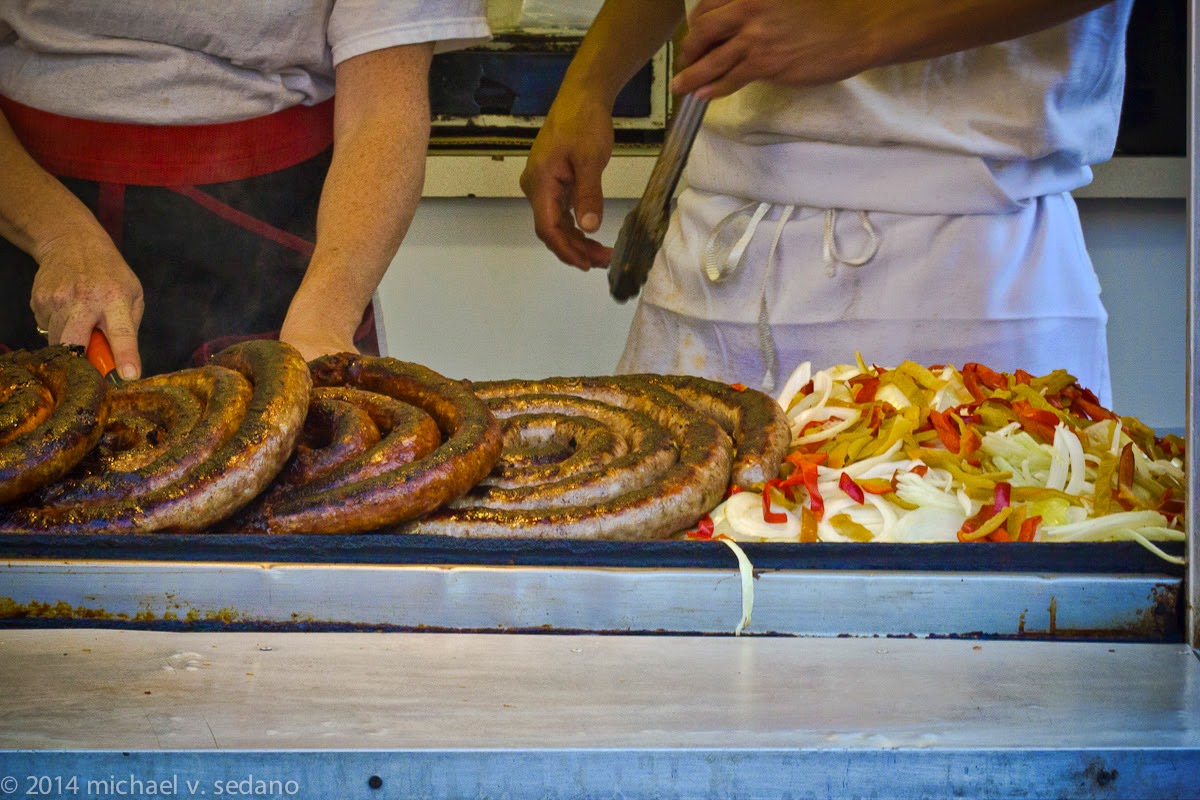
The cocinero explains Arepa ingredients are puro corn and no flour nor wheat nor barley, nor in any of the meats and cheese. That sounds safe and The Gluten-free Chicano is about to order his first ever Arepa when
gluten-free terror strikes. The
whatifs win--
what if I get sick when I’m in New York city for fun?--and I walk away, all antojado for the Venezolano specialty.
That was last year, a trip to enjoy the
Poets Forum activities at the Academy of American Poets (
link). This week serendipity rewards The Gluten-free Chicano with his first assuredly gluten-free Arepa and sabes que? It won't be the last.
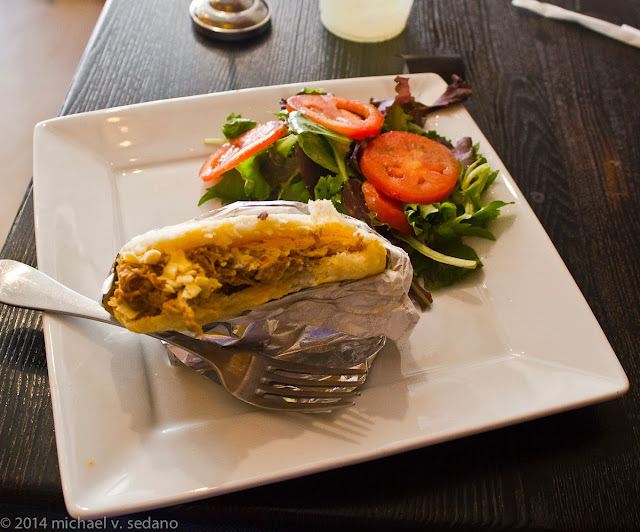 |
| Three bites short of a whole Arepa |
I'm off to a camera show, and my walk takes me past some new businesses. There's a yogurt place, something else, then a hand-printed sign in a storefront makes me hitch a step. On my return walk I'm on the look-out for that “Gluten-free Sandwich” window.
Amara is on Raymond Street in Pasadena, next door to the large municipal parking lot, first 90 minutes free. It's a short walk from the Gold line's Del Mar station.
Amara prepares coffees, sweets and sandwiches. Their
website features their choclatier and coffee specialties, along with arepas. The proprietor assures me he's familiar with el celiaco, era médico back home. In his new home, he's a restaurateur. Así es, pero ni modo. This is his place, and Alejandro knows celiac issues. No
whatifs at Amara.
I order La Propria. Arepa names both the bun and the inside, a synecdoche of the whole for the part.
Manna from heaven must have been an Arepa. Split the arepa, spoon in some carne deshebrada, add creamy gouda cheese morsels, and The Gluten-free Chicano knows he’s been delivered from the wilderness of bread-like analog food.
The pan element of the Arepa at Amara is light, fluffy, and delicately flavored.
Made with P.A.N. corn meal and water, this pan is an incredible discovery for gluten-free eating and cooking.
Alejandro and Amara welcomed The Gluten-free Chicano with incredible warmth and hospitality, which appears the standard at this worthwhile enterprise. Next time you're in Pasadena, the Arepas are on me.
 |
| Amara holds an arepa |
Mail bagHeritage Studies Celebrated in SanAntoLa Bloga friend Juan Tejeda, a principal in the daring
Aztlán Libre Press, invites gente to come to San Antonio Texas for the epitome of cultural tourism. La Bloga urges travelers to select intriguing activities and plan a few days drinking in Texas' best city and Palo Alto College's engaging seminars.
Click the poster for a larger view, or, mejor, for a full list of scheduled events including times and locations, visit
alamo.edu/pac/NAHHM. You may request information through the
Office of Student Engagement and Retention at 210-486-3125.
from Juan's email:
We have been working hard since this past summer to organize Palo Alto College's inaugural Native American/Hispanic Heritage Month Celebration 2014 in San Antonio, Tejas. We have a great schedule of activities that includes scholarly presentations, workshops, a free Chicano Batman and Sexto Sol concert, film series, readings and book signings by prominent poets and authors.
The focus of this over-a-month-long celebration is engaging our students and community on the important fact that we are Indigenous/American Indian first and foremost, and native to this continent now called America, otherwise known as Cemanahuac, Abya Yala, Turtle Continent. In an age when most of our students call themselves
Hispanic, the issue of our Indigeneity has not been addressed properly, nor our mestizaje and connection to the Indigenous populations of the Americas and our positions as Mexicans, Xicanas/os and Latinas/os in the U.S.
All events are free and open to the students and community, except for a small fee charged for the Luchadora! theater production for those 19 years and older. And there is free parking and free aguas frescos.
Late-breaking News!Poet Laureate Laurie Ann Guerrero Free WorkshopSan Antonio Poet Laureate and Palo Alto College Poet-in-Residence, Laurie Ann Guerrero, will be conducting a free one-month Creative Writing Workshop beginning Oct. 14. Details on image, click to enlarge. Guerrero is an alumna of Palo Alto College.
Mail bagPoet Laureate Feted in HoustonDetails at AP's website here.Call for PapersOn the Eastside of the city of La, at the juncture of the 10 and 710 freeways, lies California's semi-official raza university, California State University Los Angeles. CSULA, through the leadership of La Bloga friend Roberto Cantu, holds a significant annual conference exploring junctures of las culturas on ambos sides of the frontera. 2014's
theme was Rudolfo Anaya. Next up, los de abajo.
Cantu and the conference co-sponsors invite scholars to submit papers on themes surrounding the Mexican Revolution and its novels.
For details, visit the conference site (click here).October On-line Floricanto: First of BothBetty Sánchez, Joseph Ross, Robert Neustadt, Joe Morales
La Bloga and the Moderators of the Facebook group
Poets Responding to SB 1070: Poetry of Resistance share two sets of poems this month. Today, it's La Bloga's pleasure to share the first four of the month's dual delights.
Carne De Cañón por Betty Sánchez
For Gilberto Ramos by Joseph Ross
Crossing the Line by Robert Neustadt
Nothing Is Right Until You Say It Is by Joe Morales
CARNE DE CAÑÓNpor Betty SánchezMe llaman niño sin acompañante
Aunque ese no fue el caso
Cuando salí hace meses
De mi tierra
Mirando siempre adelante
Mi madre vendió un riñón
A su ambiciosa patrona
Para pagarle al coyote
Mi pasaje al infierno
Alias el norte
Que de libertad pregona
Mi tía Evelia se despojó
De su parcela y sustento
Para enviar a sus dos hijos
Al país de la abundancia
Rosita la vecina de mi infancia
Lavó ajeno tres veranos
Para escapar del abuso
De su padrastro y su hermano
Rogelio el hijo del cerrajero
No deseaba terminar
Como los demás del barrio
Siendo mara salvatrucha
Lloró incesante a su padre
Y obtuvo su bendición
Para irse al otro lado
Por ésta te juro viejo
Dijo besando la cruz
Que dólares mandaré
En cuanto consiga asilo
Mercedes la de la esquina
No conoció a su mamá
La dejó siendo pequeña
Al cuidado de su abuela
La anciana al enterarse
Que viajaríamos en grupo
Sacó dinero de un jarro
Para que fuera a buscarla
Con esperanza y con miedo
Nos brindaron triste adiós
Sin siquiera sospechar
Que al dejarnos ir solitos
Nos convertían sin querer
En ser carne de cañón
Al frente de los peligros
Vulnerables al abuso
Y la vejación de extraños
Partimos de Honduras
Cargando en el morral
Sueños y demonios
Derramando lágrimas
Emprendimos la ruta migratoria
Ignorando el infortunio
Que nos seguiría
Como una sombra funesta
Sobre nuestras cabezas
Tan pronto como
Abandonamos el hogar
Pisamos suelo hostil
Y actitudes áridas
Por nuestro atrevimiento
De anhelar un futuro mejor
Cada tramo de terreno
Que logramos recorrer
Arrastraba una historia
De miseria consigo
Cruzar las fronteras
No fue el desafío
Atravesarlas constituyó
Un acto de fe y valentía
El hombre de aspecto duro
Que nos sacó de San Pedro
Nos abandonó en Corinto
Sin podernos regresar
Proseguimos el camino
Hacia un futuro inseguro
Guatemala y México ignoraron
Nuestra condición de niños
Aduaneros y civiles
Nos trataron por igual
La fatiga y la desdicha
Se incrustaban en los huesos
Buscábamos refugio
bajo los puentes
En lugares solitarios y oscuros
Cubriendo nuestro dolor
Con cartones malolientes
Rosita y Mercedes
Vendieron su inocencia
Para saciar el hambre
Rogelio escapó de las pandillas
Pero no de la muerte
Por disentería y fiebre
En un albergue en Tabasco
Mis primos y yo hicimos
Trueque de pintas de sangre
Por un par de mantas
Para cubrirnos del
Escalofriante temor
Que nos producía
Viajar en el tren
Que llamaban la bestia
Un monstruo de mil cabezas
Semejantes a la nuestra
Perdimos cuenta del tiempo
Las semanas y los meses
Perdieron todo sentido
Eran solo pesadillas
Repetidas y con creces
Los que corrimos con suerte
Llegamos a la línea fronteriza
Junto a tantos otros miles
Queriendo cruzar de prisa
Para encontrar familiares
Otro hogar trabajo y visa
Pobres ilusos
Nosotros y nuestros padres
La bienvenida esperada
Se torno en una réplica
Exacta de lo ya acontecido
Carne de cañón de nuevo
Hacinados en jaulas
Durmiendo en el piso
Considerados indeseables
Objetos de escrutinio público
Temas de agendas políticas
Crisis nacional
Números, casos, estadísticas
Nos llaman niños sin acompañante
La estampita de la virgen de Suyapa
No cuenta en los reportes
Los derechos de los niños
Son solo un papel decorado
Con frases dignas sin valor alguno
La ley no nos protege ni nos acusa
Nuestros parientes no protestan
Por riesgo a ser deportados
Los que quedaron en el camino
Son olvidados
Nadie reclama
Sus huesos calcinados en el desierto
O bajo las vías de un ferrocarril
Que carga en sus lomos
Vidas engarzadas
Destinos similares
Otros mas se pierden en la indiferencia
De un mundo que no reconoce su humanidad
Tú que me lees
Y me ves a través de una pantalla
Que lloras al pensar en mi desgracia
Que me discutes en los medios sociales
Y me envías libros y juguetes para
Hacer mi estadía en esta prisión
Más llevadera
Que harás cuando sea enviado
De regreso a mi patria
A enfrentar la muerte
Que se disfraza de pobreza
De desempleo
De violencia …
© Betty Sánchez 1 de Septiembre de 2014
En honor a los niños indocumentados y en recuerdo de mi propia travesía que recorrí cargando sueños y demonios
Madre, abuela, maestra, poeta…en ese orden. Residente del condado de Sutter; trabajo como Directora de Centro del programa Migrante de Head Start.
Soy miembro activo del grupo literario, Escritores del Nuevo Sol desde Marzo del 2003. He sido invitada a colaborar en eventos poéticos tales como el Festival Flor y Canto, Colectivo Verso Activo, Noche de Voces Xicanas, Honrando a Facundo Cabral, y Poesía Revuelta. Ha sido un privilegio contribuir en la página Poetas Respondiendo al SB 1070, Zine 10 Mujeres de Maíz y por supuesto en La Bloga.
For Gilberto Ramos by Joseph Ross15 year-old Guatemalan boy who died
in the Texas desert, June, 2014
Before you left, your mother
draped you with fifty Hail Marys,
a rosary of white wood,
a constellation she hoped might
guide you. But Texas does not
know these prayers. It knows
that desert air is thirsty
and you are made of water.
It drank you slowly. Your name
only linked to your body by the string
ofaves still around your neck,
the small cross pressing against your
wooden skin, the color of another cross.
You left home on May seventeenth
with one change of clothes and two
countries ahead of you, your brother’s
phone number hidden on the back
of your belt buckle so the coyote
couldn’t find it. The coyotes pray
in the language of extortion.
The phone number was eventually
found by a Texas official whose name
your brother couldn’t remember. She called
and spoke in the language of bones. He translated
her news into “pray for us, sinners,
now and at the hour of our death.”
His prayer meant “brother,” a word
he kept moist, just beneath his tongue.
Published in the Los Angeles Times 8/31/14
I was born in Pomona, California, just outside of Los Angeles. After studying English at Loyola Marymount University in Los Angeles, I taught high school in Southern California and then went on to receive an M.Div. at the University of Notre Dame. I taught in Notre Dame’s Freshmen Writing Program before moving to Washington, D.C. in 2000, where I founded the Writing Center at Carroll High School, taught at American University, and currently teach in the Department of English at Gonzaga College High School.
www.JosephRoss.net.
Crossing the Lineby Robert Neustadt Little children cross the line.
Thousands,
legions of children,
seeking the love of a mother,
a father, a place to be.
A place where you can eat.
A place where you can stare at your feet,
or clouds that look like bunnies,
and not have to worry that
they’ll cut your throat,
or rape your sister,
or rape you and
cut your sister.
Thoughts. Thoughts of nine year olds?
Such are the thoughts of little children
riding the train, with hungry bellies,
cutting lines across thousands of miles,
riding rails on top of box cars.
Miles and miles and, yes, occasionally smiles.
Dreams of mami.feel the wind, it feels like we’re flying.
Rails of worry, wheels of Beast.
Don’t sleep, they’ll throw you off.
Don’t slip,
labestiawill suck you in and slice off your legs.
Swim the river, cross the desert,
Find the Migra, find Mamá.
We’re here, we made it,
the United States!.
Have we arrived?
New York, is near?
Cages. Children in little cages.
It’s like the zoo with children-as-animals--
sad young polar bears, locked inside refrigerated cages in a desert zoo.
No children with balloons on strings,
no squeals of laughter, no organ grinder music.
Just kids, never-smiling, inside cages.
This is no American Dream,
rather another segment of an endless nightmare.
Green-clad agents watch,
with guns on their belts, and tasers and clubs,
they guard the little brown children,
who dared
to cross
the crooked
lines
that divide
us
from
them.
Those
who
have
and those
who don’t
have the right
to eat,
to stare at their feet,
to find happy dreams in clouds,
to be.
Thousands of children crossed a line of water and sand.
Do we really want to hold that line?
Incarcerate children like dogs in the Pound?
Do we really want to cross that line
from human to inhumane,
shifting in shape from human to soulless steel-gutted beasts?
Robert Neustadt is Professor of Spanish and Director of Latin American Studies at Northern Arizona University. Over the last four years he has been taking students on field trips to the US/Mexico border. He co-produced and contributed a song to Border Songs, a double album in English and Spanish about the border and immigration (
http://www.bordersongs.org). All contributors donated their work and the project donates all of the sales revenue to a humanitarian organization, "No More Deaths / No más muertes." Each album of Border Songs purchased provides 29 gallons of water for migrants in the borderlands. So far the album has raised approximately $65,000 for humanitarian aid.
Nothing Is Right Until You Say It Isby Joe MoralesYou, dreamer that cries in heartbreak
whose voice wails with the injustice of it
whose voice echoes against a wall of grief
gathering round the coffins
in the long sleepless watches of the night
traveler from ancient places,
you praise the finger pointing north
in awkward persistence
if you walk far and hard enough
will the sweet smell of freedom follow?
you of time, you of silent merit
you relinquished of childhood
fair flower how do you so calmly grow?
even as you are among us, you're about to let go
even if your disrespected you’ll forgive
even if you act responsible you'll be criticized
even as you walk away you’ll remember
you’re one acquainted with the night
coyotes and vampires glisten in your window
making their morbid and evil way
hacking through old neighborhoods
while slithering through, accumulating slime,
hopelessness littering the horizon
about suffering you were never without
for you all human nature seems at odds
you see violated ones with gentle hearts die
too eager for the predictable, too late for change
you’ve been standing in line patiently, quietly
too long to measure, while others perished
you’ve now raised your voice
for weary hearts and ears to hear
for all who’ll lend a hand
for those who will fight
who'll challenge the injustice, hypocrisy
give credence to inalienable rights
knowing humanity grows if nurtured
you lend your voice
Joe Morales is an artist, poet, writer, singer/songwriter and producer from Boyle Heights now living in South San Gabriel. Married and has three children. Retired but continues to expand boundaries, generate interesting projects and cultivate new friendships.

By: Emily Smith Pearce,
on 8/11/2014
Blog:
Emily Smith Pearce
(
Login to Add to MyJacketFlap)
JacketFlap tags:
Food,
Recipes,
cooking,
recipe,
Gluten Free,
vegetarian,
burger,
vegan,
gluten-free,
Add a tag
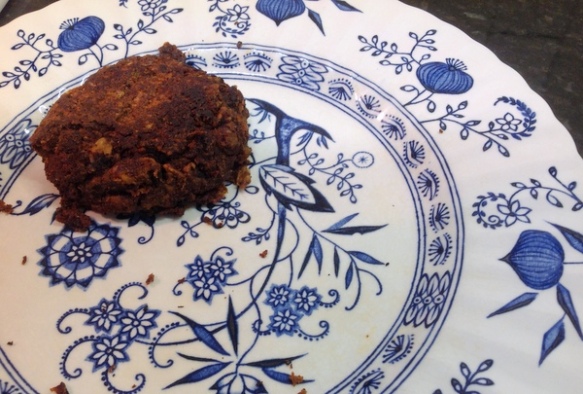
I’d been wanting to try these for a long time but never got around to it until last week. There were a few mishaps, but all in all, I was psyched about how they turned out, despite their less-than-photogenic looks. They even got the hubs stamp of approval—-as in, he not only ate them without complaint (he pretty much always does that) but says he’d like me to make them again. He even chose them leftover the next day instead of grilled chicken.
The recipe is adapted from Mark Bittman’s How to Cook Everything Vegetarian. Here’s the original recipe. I’ve cooked a lot, lot, lot from this book. Check out my archives if you want to see more posts about food and cooking.
1 can black beans, drained
1 medium onion, roughly chopped
1/2 cup old-fashioned oats (I used gluten-free)
1 TB chili powder
1 garlic clove
a generous squirt of Sriracha sauce
a nice blob o’ ketchup
3 pickled jalapeno slices
Pulse everything just a little, not a lot, in the food processor. I accidentally left out the egg, but it didn’t seem to matter much, so I doubt I’d add it back in. I also goofed and blended the ingredients too long.
After processing, let it all rest a few minutes.
Form into patties and chill in the fridge for a little while.
Heat a cast-iron skillet to medium, add oil, then brown the patties on one side, then the other.
The next bit was tricky for me. The burgers actually had to be cooked a long, long time to get the right texture. You want the texture to be kind of burger-like. The right kind of chew, not mushy and damp.Maybe I had trouble because I added too much moisture and pulsed the ingredients too long. I don’t know. I may try browning and then baking next time.
What I ended up doing was just turning the heat down to low and cooking them forever very slowly so as not to burn them. I was afraid the whole experiment would be a wash, but lo and behold, they turned out very well in the end.
I didn’t think they were more than mildly spicy, but my daughter (who likes to remind me that children have more taste buds) said the spice factor was too much for her. I hadn’t expected the kids to flock toward bean burgers anyway and had made them turkey burgers instead.
You could totally crank the spice factor up or down. These are definitely going into the rotation.
If you want more detail about all kinds of tips and variations, do check out the original recipe.
I’ve been reading Jennifer Worth’s memoir, Call the Midwife, since I love the show so much. I was surprised that the show actually follows the memoir fairly closely. I’ve been watching old episodes of Foyle’s War, a British WWII detective show. Also tried Outlander (no, I’ve never read the books) and The Knick. I’m definitely on a mostly British historical kick. Not sure what I think of those shows yet. You?
Also doing some patchwork, some of which I hope to show you soon.



When we were living in Hannover, I became a falafel addict. Might not sound typically German, but there’s a large Turkish population in Germany, and you can buy inexpensive, fresh, delicious falafel (as well as other yummy treats) at almost any corner. The guys at my imbiss (fast food joint) knew my falafel order by heart.
You can get excellent falafel in Charlotte (try Zeitouni), but I miss being able to walk across the street and get it, so I often make it at home. Box mixes are actually pretty good (Far East has a good one) but I’d always wanted to try making them from scratch.
So what’s in there? Dried, soaked (uncooked) chickpeas, onion, parsley, spices.
How hard was it? Well, if you’ve made from-the-box falafel before, it’s really not that hard, but it does require more planning and more cleanup. Big bonus if you have trouble with gluten is that making them from scratch requires no flour, which most mixes have. I find the difficult part is that I want to make all the fixin’s, too, which also take time—yogurt sauce, tahini sauce, chopped veggies.
Since I spent most of my energies on the falafel, I put my daughter to work on the yogurt sauce (she loves this) and dressed the veggies with just a little lemon juice, salt, and pepper.
This time I think my husband was right: I really DID use every dish in the house.
Results: delicious. Was it worth making from scratch? I have to say that, while I loved them would make them again, the box-mix kind are a close second.
Bittman’s recipe here.

Next on my list: making harissa from scratch, and Egyptian falafel. They’re green!
For more of my posts on cooking and food, click here.


Review: Linda Rodriguez. Every Hidden Fear. NY: Minotaur Books, 2014.
ISBN 978-1250049155
Michael Sedano
Something there is that does not love a Summer Book. The intent grad student with one hundred years of novels to read by September. The television programmer who wants you to sit open-mouthed in the dark watching re-runs. The curmudgeon who wants no one to have any fun and sneers at “genre fiction.”
Those tipos don’t love a Summer Book.
But grad students can use a break. Re-runs, give me a break. Curmudgeons will refuse to have fun, even with the kind of book tolerant gente want to read cover to cover--non-stop si se puede and the phone is Off.
When you pick up a Summer Book you intend to be happily absorbed by cool characters in rip-roaring stories. While you don’t intend to take notes you dog-ear provocative, memorable, artful passages where the author’s having lots of fun, too. In short, you intend to be entertained, and that’s what’s in store from
Every Hidden Fear by Linda Rodriguez.
Rodriguez writes like she’s enjoying herself. Lavishing pages to develop a hateful asshole character who deserves to be dead, introducing detective Skeet Bannion and various residents of a small Missouri town threatened by real estate moguls from nearby Kansas City, killing him takes a while. Then the author kills the jerk with gruesome excess. Justice requires Skeet Bannion to step up in the face of inept local policing.
Bannion comes with a history of hair-raising times in cases sketchily alluded in passing detail. In fact,
Every Hidden Fear will motivate readers to seek out Linda Rodriguez’ two earlier Skeet Bannion novels,
Every Last Secret and Every Broken Trust. The Cherokee connection adds a unique resource to the character’s potential.
The detective’s a real-looking character, not some hot chick but plain old her. But there’s something about Skeet that has the local cop and a big muscular vato sniffing around. Skeet says it’s not important, keeps her nose to the grindstone as compense for no sex “in a while.”
Everyone else is hooking up. The little town has lots of good-looking women, old and young, who fell for the young heartthrob who left town and a knocked-up beauty behind. When the appropriately named Ash returns as front man for the mall developer, he threatens to name names. He claims fatherhood of the son in a public cuckolding of teenager’s father. He lives up to his name, ash-hole.
Skeet's teenager finds himself in a love triangle between the railroaded suspect, a teen heart throb girl, and himself. The girl lives with an evil stepmother, the one who gleefully describes Skeet’s beauty faults. The evil stepmother is hooking up with Ash’s rich, evil employer, himself a rapist.
What a suspect list. "Joe, you've got a strong suspect in Peter…Bea was most likely sexually involved with Ash when he was a kid…Walker was furious with Ash for causing all this trouble".
No spoilers here. Summer reads are supposed to be fun and Linda Rodriguez has enough formula to keep the pages flying by. There’s romance, intrigue, back-biting, crummy people you can’t do anything about. And there are serious issues like senior abuse versus senior love, steamroller economic development, growing up.
Rodriguez weaves a lament for hometowns throughout the book, in frequent references to passing trains, and walking. Trains become particularly potent. Every chapter carries at least one instance where Skeet hears a train rumbling through town. The motif becomes eccentric, noticed. It’s a set-up.
“You noticed?” the author seems to say, having fun, when she has the failing cop, Joe, make her point about disappearing hometown economies. “Wish they hadn’t destroyed the trains. America’s railroads were the envy of the world, but we gutted them, and now can’t get to most places in this country by train. Damn shame!” I dog-eared that page.
With summer’s slower pace and vacation time, a Summer Book fills the leisure time need for fun, entertainment, and every now and again, something to make you sit up and take notice. Turn off teevee. Take a break. There’s a lot to “genre” writing that deserves attention. A good start in 2014’s Summer Book list is Linda Rodriguez’ Skeet Bannion novel,
Every Hidden Fear.
The Gluten-free Chicano CooksGluten-free Breakfast CrepeCrunchy peanut butter and maple syrup wait on the table for the morning’s sweet beginning. You can prepare bacon, weenies, or ham in advance. These delectable delights cook in about five minutes, and you can turn out a batch of these in a short time.
This recipe makes a thin batter that spreads to fill a cooking surface. Two eggs create a creamy texture. Enhanced with sour cream and equal portions flour and milk, the batter cooks into a thin, flexible pancake you can use as a dinner entrée, a breakfast treat, or a quick merienda when the occasion fits.
 Breakfast Crepe
Breakfast CrepeServes two or more, half hour refrigerator to table.
Two eggs
¼ cup King Arthur gluten-free flour
Pinch baking soda
Pinch baking powder
Vanilla or other flavoring to taste
¼ cup milk
1 tbs sour cream
greased non-stick frying pan, hot
Hold the Vanilla when you plan a savory filling like
garlic butter. Look for The Gluten-free Chicano's
Garlic Crepe in a future La Bloga.
Beat the eggs frothy with the dry ingredients and vanilla. Then add the flour and incorporate it into the eggs.
Whip in a tablespoon of sour cream. Be vigorous but don't mind a smattering of white spots where you didn't get all the sour cream into the mixture. You could substitute melted butter.
A non-stick surface is essential. Ladle a small amount into a hot pan, just enough to cover the bottom. Hot means the flame touches the bottom of the pan and nearly smokes. Let the crepe bubble before turning.
If you're good, flip the pan. I use a spatula, tilt the pan and delicately flip over. Don't worry about liquid; lift the crepe and let the liquid slide under then flip the crepe atop that.
The dappled surface indicates a hot surface. This thin batter cooks quickly once turned, half a minute or less.
The eggy batter is rich and flexible. The pockets formed on this side capture fillings if served this side up, or rolled with the outer side the first pour.
On-line Floricanto
<!--[if gte mso 9]> Normal 0 false false false EN-US JA X-NONE <![endif]--> Frank de Jesus Acosta, Xico González, Frank de Jesus Acosta, John Martinez, Fernando Rodriguez, Francisco X. Alarcón
Maya's Gift (Honoring Maya Angelou)
by Frank de Jesus Acosta
Today a poet became her poems
Soulful songs of the caged bird
Child of Africa, cradle of humankind
Legacy of slavery, an American anathema
Inheritance of hope, spiritual defiance
Heart of conviction, defying abhorrent hate
Unbroken by bigotry, sexism, or poverty
Claiming the inalienable ways of love
Walking a life of advocacy, sovereignty
Inspiring women to rise in inherent divinity
Admonishing men to live in fullness of equality
Spirit pen of justice, revealing painful truth
Lies of history, dogma of tyranny, canons of greed
Envisioning a world with prose of possibility
Verses of healing for wounded generations
Women, mother, sister, friend, warrior shaman
Today you ascend, our guardian lyricist ancestor
Leaving us a literary legacy of eternal living words
Seeds of love; that the poem within us all may rise
Poem by: Frank de Jesus Acosta
Original Dreamers
by Xico González
In the immigrants’ rights movement
often times we hear of the Dreamers
with their graduation gowns
fists in the air
and beautiful butterflies
Marchas, rallies and sit-ins
that lead to deportations
Sacrificios de sueños soñados
In senators’ offices
self-sacrificing dreamers
get arrested and deported
to prove a point:
the US immigration system is broken
For the dreamers,
la escuela o los guachos
Dos caminos
that end in papeles and green cards
Let me ask you a question,
what about the original dreamers?
Who speaks for them nowadays?
They have sueños too
Have we forgotten about the
padres, madres
hermanos y hermanas
that came to the US too old
to go to school
or join the armed forces
They have sueños too
Pero le tubieron que chingar
In low paying jobs
como los files, la construcción, los hoteles,
rich people’s homes, and restaurants
You know the ones bumping
cumbias, norteñas, banda y racheras
in kitchens across the United States
The ones that yell,
“Apurate güey,”
“ya esta listo güey,”
“No mames güey,”
They have sueños too,
They dream that their children
will have a better life in this country
instead of discrimination and exploitation
They have sueños too
Migra raids at workplaces
that lead to deportations
Sacrificios de sueños soñados
For the original dreamers,
el trabajo y la explotación
Dos caminos
that end in fear and shadows
They have sueños too
Jesús
El jóven que trabaja en la construcción en la Bahía
has dreams too
María
La señora que cuida güeritos en Hollywood Hills
has dreams too
Jóse
El señor que trabaja en los files del Valle de San Joaquín
has dreams too
So let us help the original dreamers
dream their dreams of a better future
without the fear of being deported,
Exploited and used
Next time you hear of the Dreamers
think of their parents and siblings
because they share the same dream
They have sueños too.
© Xico González
5/21/2014
C/S
I wrote this poem for the event "Filed Away: The Undocumented Experience," a conversation and exhibit sponsored by UCD SPEAK and the UCD Cross Culture Center. The poem was inspired by two posters that I created for the 1ro de mayo: Dia del Trabajador Rally and Marcha in Sacramento.
Maya's Gift (Honoring Maya Angelou)
by Frank de Jesus Acosta
Today a poet became her poems
Soulful songs of the caged bird
Child of Africa, cradle of humankind
Legacy of slavery, an American anathema
Inheritance of hope, spiritual defiance
Heart of conviction, defying abhorrent hate
Unbroken by bigotry, sexism, or poverty
Claiming the inalienable ways of love
Walking a life of advocacy, sovereignty
Inspiring women to rise in inherent divinity
Admonishing men to live in fullness of equality
Spirit pen of justice, revealing painful truth
Lies of history, dogma of tyranny, canons of greed
Envisioning a world with prose of possibility
Verses of healing for wounded generations
Women, mother, sister, friend, warrior shaman
Today you ascend, our guardian lyricist ancestor
Leaving us a literary legacy of eternal living words
Seeds of love; that the poem within us all may rise
I Love You Forever Olivia
by John Martinez
For my mother
It is not a dream, but a loop,
A replay of her breast falling
From my sleeping face
The dawn, the sycamore
In the window, her hand
Hushing my lips
When I cried out,
Squeezed between
Her soft folds
And time doesn't fade,
But lingers in the crevices,
Between sweat and laughter,
How she combed my hair,
With hands of pain and joy
No, the sky won’t bring
Her back, bundled
In wings, as promised,
No golden chalice
Pointing her path to me
She lives right here,
In the journey of my blood,
She will always be-
So when the wind smiles
Into my window,
With the fruit of her breath,
I will always say:
"I love you forever, Olivia"
© John Martinez
All Rights Reserved
Mother
by Fernando Rodriguez
A single human being
can take many jobs
can make many shifts
Vacations there's not
Courageous, brave, strong
Delicate to the touch
Yet hard to the bone
A restless being
Night without sleep
Sacrifice all and all that she has
Kisses and love struggles and more
The hardest profession
The worst valued one
There's billions of women
but mother just one
A day in a year for sure it’s not fair
To thank all the efforts
And all that she cares
Thank You mother
Today in your day
AZUL SIN FRONTERAS BORDERLESS BLUE
por Francisco X. Alarcón by Francisco X. Alarcón
Via James Downs:
From a new book of bilingual eco-poems by Francisco X. Alarcón, Borderless Butterflies: Earth Haikus And Other Poems / Mariposas sin fronteras: Haikús terrenales y ottos poemas that will be published by Poetic Matrix Press in 2014.
BIOS
<!--[if gte mso 9]> Normal 0 false false false EN-US JA X-NONE <![endif]--> Frank de Jesus Acosta, Xico González, John Martinez, Fernando Rodriguez, Francisco X. Alarcón

Frank de Jesus Acosta is principal of Acosta & Associates, a California-based consulting group that specializes in professional support services to public and private social change ventures in the areas of children, youth and family services, violence prevention, community development, and cultural fluency. In 2007, he authored, The History of Barrios Unidos, Cultura Es Cura, Healing Community Violence, published by Arte Publico Press, University of Houston. Acosta is a graduate of University of California, Los Angeles (UCLA). His professional experience includes serving in executive leadership positions with The California Wellness Foundation, the Coalition for Humane Immigration Rights of Los Angeles (CHIRLA), Downtown Immigrant Advocates (DIA), the Center for Community Change, and the UCLA Community Programs Office. He is presently focused on completing the writing and publishing a two book series for Arte Publico Press focused on best practices to improve the well-being of Latino young men and boys. Acosta most recently co-authored a published “Brown Paper” with Jerry Tello of the National Latino Fatherhood and Family Institute (NLFFI) entitled, “Lifting Latinos Up by Their Rootstraps: Moving Beyond Trauma Through a Healing-Informed Framework for Latino Boys and Men.” Acosta provides writing and strategic professional support in research, planning, and development to foundations and community-focused institutions on select initiatives focused on advancing social justice, equity, and pluralism. He is also finalizing writing and editing a book of inter-cultural poetry and spiritual reflections.

Xico González is an educator, artist, poet, and a political and cultural activista based in Sacramento, California. He received a MA in Spanish from Sacramento State, and a MFA in Art Studio from the University of California at Davis. González currently teaches Spanish and Art Studio at the Met Sacramento High School.
The work of Xico González seeks to empower people uniting in common cause against a common oppressor disguised in different máscaras. Gonzalez's silkscreen posters address and support numerous political causes, such as the struggle for immigrants' rights, the Palestinian and Zapatista struggles, and the right for Chicana/o self determination. González is not only an artist, but is also an activist/organizer that puts his artistic skills to the benefit of his community. Xico's work contributes to the long dialogue of art, activism and the legacy of the Chicano Art Movement. González has been influenced primarily by his mentors, Chicano artists Ricardo Favela (RIP), and Malaquías Montoya, and by early Chicano art collectives like the Mexican American Liberation Art Front (MALA-F), and the Rebel Chicano Art Front also known as the Royal Chicano Air Force (RCAF).
<!--[if gte mso 9]>
Normal 0 false false false EN-US JA X-NONE <![endif]-->
John Martinez studied Creative Writing at Fresno State University. He has published poetry in El Tecolote, Red Trapeze and The LA Weekly. Recently, he has posted poems on Poets Responding to SB1070 and this will be his fifth poem published in La Bloga. He has performed (as a musician/political activist, poet) with Teatro De La Tierra, Los Perros Del Pueblo and TROKA, a Poetry Ensemble (lead by poet Juan Felipe Herrera) and he has toured with several cumbia bands throughout the Central Valley and Los Angeles. For the last 17 years, he has worked as an Administrator for a Los Angeles Law Firm. He makes home in Upland, California with his beautiful wife, Rosa America y Familia.
My name is fernando Rodriguez and i decided to express myself in this poem as a gift for all the mothers because of what they do all year round. Writing gives me freedom and freedom gives me joy, joy gives me happiness and happiness is what we look for.
Francisco X. Alarcón, award winning Chicano poet and educator, was born in Los Angeles, grew up in Guadalajara, Mexico, and now lives in Davis, where he teaches at the University of California. He is the author of thirteen volumes of poetry, including, Ce • Uno • One: Poems for the New Sun (Swan Scythe Press 2010), From the Other Side of Night: New and Selected Poems (University of Arizona Press 2002). He has two books poems coming out this year, Borderless Butterflies / Mariposas sin fronteras will be published by Fall 2014 by Poetic Matrix Press, and Canto hondo / Deep Song will be published by the University of Arizona Press at the end of 2014.
Francisco is also the author of four acclaimed books of bilingual poems from children on the seasons of the year originally published by Children Book Press, now an imprint of Lee & Low Books: Laughing Tomatoes and Other Spring Poems (1997), From the Bellybutton of the Moon and Other Summer Poems (1998), Angels Ride Bikes and Other Fall Poems (1999), Iguanas in the Snow and Other Winter Poems (2001). He has published two other bilingual books for children, Poems to Dream Together (2005) and Animal Poems of the Iguazú (2008).
He has received numerous literary awards and prizes for his works, like the American Book Award, the Pen Oakland Josephine Miles Award, the Chicano Literary Prize, the Fred Cody Lifetime Achievement Award, the Jane Adams Honor Book Award, and several Pura Belpré Honor Awards by the American Library Association. He is the creator of the Facebook page, POETS RESPONDING TO SB 1070.
Review: Water & Power. Written and Directed by Richard Montoya. Opened May 2 in limited release.
Michael Sedano
Spider Man outdraws the Water & Power twins ten-to-one. In 16 theaters over opening weekend, the Richard Montoya written and directed independent film pulls in 2350 ticket buyers per house, weekend gross $40,000. The big-budget arachnid plays 4300 screens filling 21,000 seats over Cinco de Mayo weekend, pulling in millions. The numbers are mediocre. I’m sure Spider Man’s marketers would prefer to have sold more tickets. They should have made a better movie and people wouldn't be bad-mouthing it.
Richard Montoya has made a superior film, and it’s time more people bought tickets to see Water & Power and get their friends into seats. Audiences will see every dime of the producer’s minuscule budget on screen. Dine on a visual feast of Los Angeles imagery, get pulled along by a compelling script. All in all, Water and Power is the best film gente aren’t seeing.
Should Chicanas Chicanos go see Water & Power because it's a Chicano film, or because of Richard Montoya? No, but there's that. Mejor, go see Water & Power because it's genuinely worthwhile, thoughtful entertainment. Lots of raza in-jokes but an informed audience will find Water & Power completely accessible, funny, and respectful of the audience's intelligence.
I saw Water & Power on a Monday morning in Arcadia, with maybe six movie-goers. That’s a tough thing, to be in an empty auditorium with a good flick. Water & Power comes at the viewer in fast, rough-and-tumble bits that overflow with wit and intensity. Explosive laughs and surreal surprises are so much better when a full house lets loose a Montoya-inspired belly laugh.
The story of two brothers nicknamed
Power and
Water, comes together in fragments, with childhood flashbacks adding depth to the tragedy unfolding in the lives of a pair of high-achievers. Both have contracts on their lives. The cop brother for assassinating a criminal shot-caller. The politician brother for insisting on planting a million trees along the LA River without cutting in condo developers.
With cinematographer Claudio Chea, Montoya creates visual poetry with Los Angeles its persona. The filmmakers enchant with lush night scenes, aerial shots looking down, traveling shots crossing the river channel. Chea and Montoya define “noir” by the look and feel they achieve in the play of light against blackness. Le noir, darkness, permeates places the brothers take refuge, and the choices the carnales face. Then Chea and Montoya create wonderful contrast in the bright overexposure of scenes with the ice cream-suited downtown fixer embodied by Clancy Brown. The Devil.
The fixer scenes become visual metaphors for invincible power and evil. "Come into the light," the scenes scream, echoing a biblical line “I am the way, the truth, and the life.” In the hard glare, Water learns his eastside connectas produce nothing but an opportunity to kneel at the devil’s feet. It's a savage moment leaving a viewer shifting uncomfortably in the seat.
Emilio Rivera as Norte/Sur carries the film, not solely owing to his pivotal role between the two brothers but because the script gives him all the best lines. The audience watches mystified as Water acts like a vencido, treating a respectful Norte/Sur like shit. We’re on Norte/Sur’s side now, ambivalent about the good guy. Surprise and hilarity grow from a dance scene where Norte/Sur echoes Mae West, climaxing an arrestingly surreal scene that, more than any in the film, illustrates Montoya’s diabolical wit and his careful structuring of the film to arrive at this insightful moment completely disarmed.
Norte/Sur gets the best lines in the script, and the biggest laughs. For instance, climactic desperation builds life or death tension. Various barrios up in arms are out to revenge or protect, depends on whose side they’re with. Water, Power, and Norte/Sur sort out the alliances, strategizing whom to call upon from a roll call dozens of barrios and their muscle: San Pedro muscle, and Dog Town muscle, but not Frog Town muscle because of they're hooked up with Cypress Park muscle. Then how about Los Feliz muscle? A “who’s on first-“style double take, “Los Feliz has muscle?” Los Feliz is a mostly tony neighborhood bordering on Elysian Valley, the official name of Frog Town.
Local color is a constant feature of Montoya/Culture Clash scripts.
Water & Power continues the technique, spreading the joy to the greater Los Angeles region. Out-of-towners will get most of the jokes. For sure, everyone’s going to enjoy the backhand Edward James Olmos takes when the characters are listing big Chicano stars. “Not Olmos” they declare unanimously, and Olmos—who produced the film—is crossed off the list, “no Eddie.”
Some of the juiciest, and inadvertently sentimental, local color occurs during a police line-up. Lupe Ontiveros, after a lifetime of playing house maids, steals her scenes as a brassy foul-mouthed cop. Ontiveros sounds completely convincing as an angry, empty-headed yes-woman cop acting tougher than any of the men around her. QEPD, Lupe Ontiveros.
While writer Richard Montoya is generous with the big laughs, he’s also incisive with a spectrum of lessons. Brotherhood and carnalismo come as a pair. Water and Power are little brother and big brother, but Norte/Sur is Power’s carnal. He gradually earns Water’s respect. Power and Norte/Sur’s intimacy comes with several surprises. Norte/Sur is paraplegic because Power shot him years ago. Norte/Sur is Power’s long-time snitch whose encyclopedic barrio knowledge makes Norte/Sur a kind of Greek chorus impelling the story along. I sense a sly homage to the shoeshine tipster in Baretta and Police Story.
No one will come to
Water & Power seeking stereotypes or archetypes, and those who enter the auditorium with preconceived notions about gangs, cholos, cops, and chicanos will exit shaken. Maybe not about cops. The film opens with a speeding black and white, a uniformed officer enthusiastically hitting a bong.
The film doesn’t glorify gangsters nor offer an iconic nobility. For the most part, gang bangers exist as punchlines or puppets. Cholos, on the other hand, come with a look and a sense of humor. As personified in Norte/Sur, the cholo repels the straight Water vato but adds a different dimension to the hard ass cop persona of Power.
Water & Power, for all its chicana chicano characters is not about chicanismo. The film is about power, corruption, and moral expediency. The best lack all conviction, corruption infects all over, the cops, the fixers, the gangsters, the politicians, raza, Asian, anglo alike. They all come to a line, many cross it.
It’s not a chicano question it’s multi-ethnic: When opportunity conflicts with expediency, does a moral person do the right thing, even if life depends on it?
Water & Power is puro noir. The characters do the right thing and get the bloody end of the stick anyhow. Evil walks away with clean feet, the audience walks away stunned, entertained, moved, informed. And eager to tell their friends, go see
Water & Power.How you got there, to be the one holding the stick, there’s a story in that. Told in Richard Montoya’s unique voice, it’s a story worth taking friends to see,
Water & Power.UCR Latinos in Sci-Fi Conference On-line at LatinopiaInterest among sci-fi writers and readers continues to grow around the idea to hold a science-fiction writers conference modeled on the National Latino Writers Conference once held on the National Hispanic Cultural Center's state-of-the-art campus in old Alburquerque.
Blogueros Ernest Hogan and Rudy Ch. García sat on the author panel at the recently concluded first-ever Latinos in Sci-Fi Conference hosted by the University of California, Riverside.
Jésus Treviño, a spec lit writer himself, filmed the panel and features it this week at
Latinopia.http://latinopia.com/latino-literature/latinopia-word-latino-science-fiction-1/
The Gluten-free ChicanoPeeling Nopales the No-Espina WaySadly, the title misleads a bit. Any time a cook prepares fresh nopalito pencas, an espina or two is sure to find a finger or palm. Así es, the romance of el nopal.
A sharp paring knife and careful finger placement between the espina carbuncles are two secrets to preparing nopales.
Use a washable cutting board or work on newspaper. Draw the knife around the spiny perimeter of the cactus paddle, cutting away the outer ¼ inch of spininess.
Hold the penca flat and draw the knife across the face of the penca nearly horizonally. Most espina nubs cut right off. Dip the blade in a glass of water to wash away espinitas.
Steel the blade frequently to keep the edge slicing effortlessly.

Wash the pencas. There's a white espina in the top middle of the foto below.

Slice the pencas into ¼" strips. Draw the blade at a diagonal through the strips.
The nopalitos are ready to use in a salad, a stew, with scrambled eggs. Below, nopales simmer with carne de puerco. Later, the cook will add una torta de camarón.

By: Emily Smith Pearce,
on 4/9/2014
Blog:
Emily Smith Pearce
(
Login to Add to MyJacketFlap)
JacketFlap tags:
author,
Food,
Recipes,
writing,
recipe,
Gluten Free,
vegetables,
vegetarian,
salad,
vegan,
gluten-free,
beans,
Add a tag
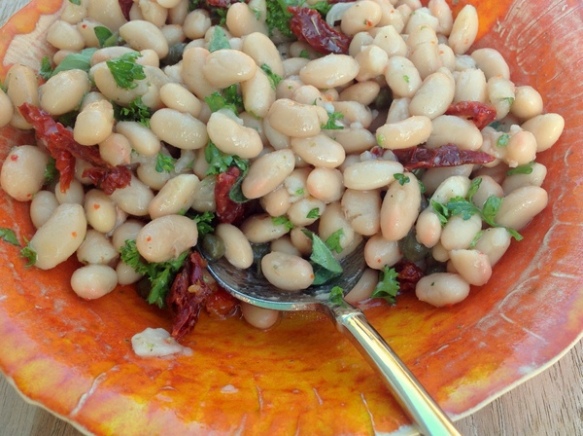
This is my weeknightified version of a Foster’s Market recipe. It’s super simple and really hits the spot when I want a tasty deli-style salad with next to no work. You could dress it up as much as you like with fresh veggie add-ins. The original recipe is lovely, though not super fast (you cook the beans yourself and make their delicious dressing from scratch, among other things). Again, this is more a list of ideas than a real recipe, but it’s not hard to eye the proportions.
Ingredients:
Rinsed and drained canned white beans (I like navy beans)
Italian dressing—-I like the Penzey’s mix
Capers
Sundried tomatoes
Chopped fresh parsley
Mix beans with enough dressing to coat and enough capers and tomatoes to give it a little color. Let marinate a few hours if you have time. Add parsley. Enjoy!
Got some more feedback on my nonfiction manuscript this week. Things are finally moving forward. So excited.
Still working on the last few chapters of my young adult novel. It’s slow-going, but I do think I’m getting somewhere.
And in other news this week, I’ve been talking to 4th and 5th graders about writing an early reader (i.e. Slowpoke). Fun times! Love getting their questions.
For more food-related posts, click here. Have a great rest of your week.


 How about a final soup to say good-bye to cold-weather? Am I jinxing us just writing that?
How about a final soup to say good-bye to cold-weather? Am I jinxing us just writing that?
I was going to call this a Greek chicken soup, but it’s really just Greek-inspired. I like to make it when I’m feeling a little tired of our usual chicken noodle with carrot and onion version.
This is less a recipe and more an idea for flavors.
You need:
–chopped cooked chicken (I usually poach* some breasts. Roasting bone-in is probably the most flavorful way you could go, but poaching is quick and painless)
–chicken broth (I use chicken base and water)
–cooked rice
–pre-cooked or drained and rinsed canned white beans. I like navy beans.
Assemble and heat gently until hot. Then add:
–chopped tomatoes (I used cherry ones since they’re always available and good)
–oregano (I grow it in the back yard, but dried is also ok—-as I look at my photo I see what appears to be parsley. hmmm…well, that will work, too and is also growing in the back yard)
–juice from 1/4 to 1/2 lemon
Enjoy! For more of my cooking and eating adventures, click here.

Hoping the weather is sunny and warm wherever you are.
Things making me happy this week (besides the lovely weather): I discovered the NPR Pop Culture Happy Hour podcast. Smart people talking about tv and movies. A dream!
Speaking of dreaming, I’ve been tweeting what my imaginary personal chef would make me for lunch if she existed. If you want to dream-eat with me, find me @emilysmithpearc on Twitter.
Also, Call the Midwife is back! And, I finished a draft of my nonfiction manuscript and sent it off for comment. Wahoo!
And now, trying very hard to focus on finishing this draft of my novel. Nose to grindstone.
*Poaching is like allllmost boiling something, but don’t let it come to a boil. Cook slowly at the almost boiling point until done, and you’ll have tender chicken. Boiling will give you a rubbery mess.
See you again soon!


The Gluten-free Chicano CooksTomatillo Sauce Versatile, Naturally Gluten-freeMichael Sedano
 |
| Sprawling among zucchini plants, tomatillo plants create shade mulch |
Tomatillos naturalize after their first year in a garden. A plant sprawls, fruit drops, rots and deposits seeds. Over the course of the season the seeds, and whole tomatillos, get mixed into the loam.
Throughout late Spring, Summer into early Fall, volunteer tomatillo seedlings need to be weeded out, else they take over the garden.
 |
| This clump grows from a fruit dropped at center right in the foto above. |
An early Spring prize is a small mound of seedlings marking the spot where a tomatillo buried whole has sprung back to life. Here is this season's crop of fresh tomatillos.
The tough seedlings take well to being dug up and transplanted to macetas. When the garden’s established, I plant tomatillos where they’ll sprawl to provide shade mulch and picking excursions. Water usage in drought means reduce water evaporation after you've reduced water usage. My vegetable garden borders a swimming pool, so every drop saved is another day less in purgatory.
There must be an horticultural rule, the bigger the fruit the smaller the flavor. I’ve eaten tomatillos grown larger than a small beefsteak tomato and won’t go out of my way to buy that variety.
My garden grows a tomatillo with fruit the size of a fat radish. It tastes OK, but the most intense flavor comes from a tiny olive-sized tomatillo with a lemony bite that enhances companion flavors. I saw that tomatillo on a Steinbeck walk through Salinas once, but the fruit wasn’t ripe enough for seed. Too bad Steinbeck wasn't born in the Fall.
Tomatillo sauce brings versatility to the kitchen from elegant entrée to finger-licking good snacks. Use this as enchilada sauce. Melt it with grated cheese or just warm it and serve as a dip. Stir ready-made carnitas into a sartén of salsa de tomatillo. Add lots of jalapeños o hueros o serranos o thai and use as taco or nacho sauce.
Modern appliances make speedy work of making tomatillo sauce. Broiler, blender, table.
Once in a cook’s lifetime you deserve to lay a chile and a tomato on an open burner, use your fingers to roll them around while the skin blackens and the juices begin to boil out. Smoke wafts up from the burner. When the chiles are really chilosos the smoke streaming into your nose burns making you cough and sneeze. Juggle the steaming handful as you drop them into the molcahete and run cold water across your palms with a sigh of relief then splash water on your face to stem the glow.
For gente on the go, comida corrida meets lots of needs. Broil. Whiz. Done. This salsa de tomatillo is almost fast.
Cleaning the ingredients takes only a bit of time, yet a busy person might consider making several quarts of sauce on a weekend and freeze in meal-size quantities, or eat it every day, on eggs for breakfast, in a taco for lunch, chile verde for dinner.
Ten minutes under a high flame broiler, or on a slightly oiled frying pan, blackens spots on the onion, tomato, garlic, chile, tomatillo. Add fresh cilantro sprigs to the blender. If the veggies get a little too done, most of the black stuff peels off and the rest adds flavor and character to your dish.
When you whiz up hot liquids keep the blender top ajar and cover the top with a dishrag before turning on the motor. The vegetables produce a good volume of nectar that you can drain off and use as a soup base, or incorporate it into your salsa.
When you use a lot more tomatillo than chiles, you make tomatillo sauce. If you use a few tomatillos and a large number of chiles, you make chile. "Chilly" in English.

Roast some extra chile pods and after the first few seconds in the blender, taste and add chiles to enhance the heat. Brighten the taste with a squeeze of lemon and pinch of salt.
Salsa de tomatillo is delicious as a simple dip. Warm it, and do your guests a flavor favor. Break chicharrones into small pieces, warm them to bring out amazing flavor, then serve and sit back and hear your guests exclaim about the most delicious chicharrones they've ever eaten. And oh yeah, that green sauce is really good.
Click here for a step-by-step narrative accompanying these fotos.Two Million Eyes < Ten Years |
Scroll to the bottom of La Bloga, in the
left corner there's the visitor counter. |
Back when I was working for a living one of my standard lessons as a corporate trainer was "have a plan, work the plan, if you don't have a plan, any which way will get you there."
That was a bad thing, the
any which way part. Winning by accident, instead of winning on purpose.
All this to bring up the magic of one million people bringing their interest and time to see what La Bloga has today. That's a victory for Chicana Chicano, Latina Latino Literature, y más.
We didn't start out with a goal to do other than write a blog centered around chicana and chicano literature, to reignite ongoing accord with similar minded gente that started at CHICLE. Now, half a year short of our ten year anniversary that magic number rolls around.
Rudy, Manuel, and I had not met in person but only via the auspices of María Teresa Márquez' much-missed CHICLE listserv. When UNM closed down CHICLE in 1999 it shut off one of the nation's only public venues for talking about chicana chicano literature. Rudy and Manuel kicked the idea around the Denver block, they emailed me in LA, and we launched. After a few issues, Daniel Olivas joined and La Bloga's team of writers has grown steadily since.
It's been a pleasure these million times, gente. Thank you for reading La Bloga.
Aural On-line Floricanto: Pablo Neruda's "La tierra se llama Juan" read by Elda MartinezStudents recorded this reading of Neruda in a media production class I taught at CSULA in the late 1970s. The kids brought
500 Años del Pueblo Chicano 500 Years of Chicano History in Picturesfrom their C/S 101 class and I gave them a handful of literature anthologies. These are the central resources of the production
Chicano Messages of Liberation that I am digitizing from audiotape and 35mm slides.
When the team wanted the script to include Neruda I challenged them to defend it as Chicano Literature. "It's in the book!" they proved.
The were happy to edit out the overtly soviet communism at the end, making makes it a better reading and a better poem.
Here's the full text. Click here if media fails to play:
http://readraza.com/poem_juan.mp3
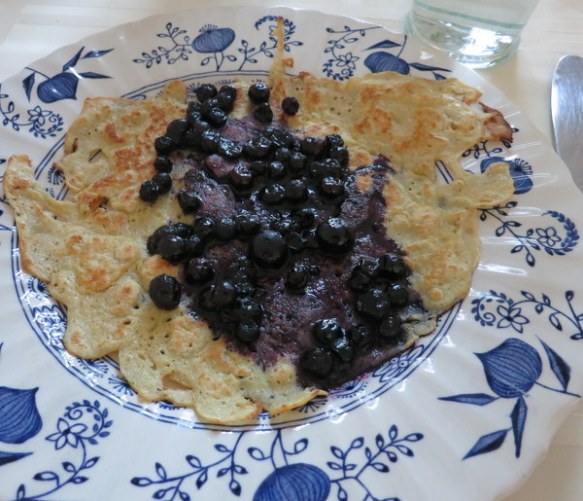
My friend Jamie first introduced homemade crepes to me when we used to do Thanksgiving together in Boston. Oh, those were fun times! We’d make crepes in the morning and just cook, cook, cook all day and listen to “Alice’s Restaurant,” that classic Thanksgiving tale.
Before that crepes had seemed so mysterious and fancy, but really, once you do them a couple of times, they’re no more difficult than pancakes. You just have to get the knack of how thick the batter should be (not very) and when to flip them (when the first inch or two of the edges are dry). Turns out it’s super easy to make gluten-free crepes, and they’re quite a bit faster than waffles.
Once again I used Artisanal Gluten-Free Cooking with great results. A similar recipe is here on their blog (I didn’t use cinnamon). The one thing I would say is that the batter was a little bit thick, so I had to add a little more milk (I think I used almond milk). You want the batter to be just a bit thinner than regular pancake batter. The photo above is of the very first crepe, before I thinned the batter, so the shape is kinda crazy. But normally the crepes look and taste the same as regular ones. They were a big hit with the family.
Lately I’ve been making blueberry syrup with a big handful of frozen berries and just a tablespoon or so of maple syrup. I put them together in a microwaveable container, heat for a little bit (30 seconds?) and voila!
I’ve been slogging away at my novel, revising and adding new material. Also reading One Summer by Bill Bryson, a history of the summer of 1927. Very interesting. Crazy times!
Also, Wes Anderson’s new movie, The Grand Budapest Hotel, is now on my must-see list. Not sure if it’s related, but I’ve been dreaming about weird European hotels lately. Hmmmm…
Coming soon: pics of a recently finished sewing project. Hope you’re having a good week!


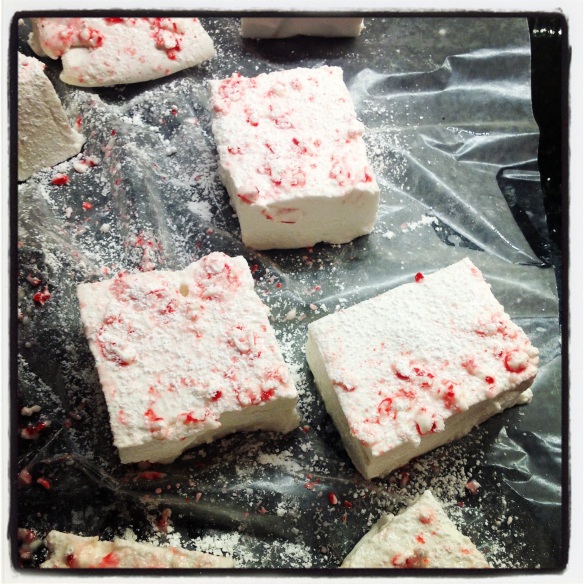
We actually made these around Christmas, as a rainy day activity with the kids. We just followed Martha Stewart’s recipe and added some crushed peppermint candy on top.
We loved the way the concoction of sugar and gelatin morphs into white foam. It made me feel like a chemist (my chemist grandfather, by the way, loves to make candy and measures things out neatly on little squares of waxed paper).

True to form, I tried to cut out some of the sugar, as drowning the finished cubes in yet more white stuff seemed a bit excessive. Turns out, though, that you kind of need the powdered sugar on top at the end to keep the marshmallows from being a total sticky mess. It’s like flour, I guess, when you’re rolling out pizza dough.
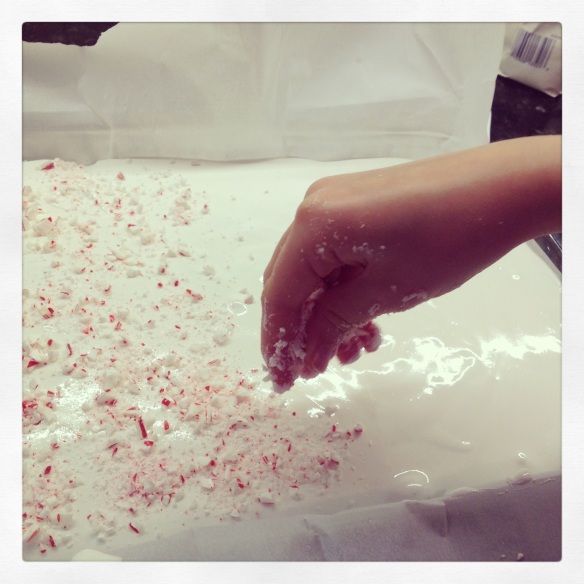
Marshmallows weren’t hard to make but they were definitely messy, even for my high mess threshold. I would totally recommend a giveaway plan, since even my kids, who were sure they’d want to eat the whole pan on their own, couldn’t finish them before they were past their prime (a couple of days).
The best part for me was having a giant marshmallow (we call them marsh planets) to put in my hot cocoa, which I made not-too-sweet on purpose.

For more of my cooking and eating adventures, go here.
Around these parts we’re still being absolutely buried by fourth grade homework (what’s up with that?). I’m still loving, really loving My Berlin Kitchen by food blogger Lisa Weiss of The Wednesday Chef. It’s got love, travel, international friends and family, and recipes to boot. Currently dreaming of baby artichokes with potatoes and separately, braised endive. Never thought I’d be interested in endive, but she makes it sound so exciting! As an added bonus, the book is making me want to keep writing, and in my mind that’s the best kind of book.
I’ve been sewing a bit, some of which you can see on my Instagram feed. You can find me there under Emily Smith Pearce or in the lower righthand corner of my blog homepage.
This interview with writer/ director David O. Russell (of Silver Linings Playbook and American Hustle) was so good I may have to listen to it again. I also loved reading this interview with the author, the illustrator, and the translator of Sydney Taylor Award honor book The War Within These Walls. The translator (Laura Watkinson) is a friend of mine in Amsterdam, and the interviewer (Joyce Moyer Hostetter) is a friend here in North Carolina. Small world!
Also just sent out my nonfiction manuscript to some early reader friends. So excited to be moving ahead with it. How are you? Cooking/ reading/ watching anything good?



We’ve made gluten-free waffles before with our gf oat and buckwheat pancake batter, but these waffles are more traditional and fluffy. My daughter and mother-in-law were the first to try out this recipe, and everyone agreed they were delicious, gluten eaters or no.
Once again, the recipe comes from our go-to GF cookbook, Artisanal Gluten-Free Cooking. You make your own flour blend and then use it for various recipes. Waffle recipe here.
In other news, we have a snow day here. Enough snow to make the roads dangerous, but not quite enough to really play in it. The kids are making do, with gusto. Meanwhile I’m having trouble concentrating on what I should be doing. Keep checking my to-do list. I should mention that our daughter made the waffles again today, and it was surely a nice mid-week treat. Hope you are warm and cozy—-or at least, bundled appropriately and having fun.
For more of my cooking and eating adventures (many of which are gluten-free), click here. I’m about to add a new gluten-free tab so you can see all those in one place. Enjoy!


I was tagged by my friend
Sue Fliess to participate in a blog tour. Sue is the author of a soon-to-be-released book that I illustrated called
"A Gluten-Free Birthday For Me!" Sue tagged me about a month ago and I've been busy busy busy. But hopefully "better late than never" still applies.
Here are the questions that I am suppose to answer...
1 What is the working title of your next book? I'm really excited about my next two books. The first is called
The Ice Cream Shop. It's being released by Scholastic next summer (2014) A second book called
The Sea Monster is scheduled for the fall.
2 Where did the book idea come from for the book? A couple of years ago, in lieu of sending out Christmas cards, I sent out mini Christmas comic books featuring two characters named Steve and Wessley. Those two guys have decided to stick around in my head and worm their way into several more stories.
The Ice Cream Shop and
The Sea Monster are the first two being put to paper.
3 What genre does your book fall into? This is a level 1 early reader similar to my other book,
May I Please Have a Cookie? 4) What actors would you choose to play the part of your characters in a movie rendition?
Oh, they would definitely play themselves as it would probably be an animated short film. John Lasseter are you listening??
5) What is the one-sentence synopsis of your book?
Steve learns that reading signs can be very important.
6) Who is publishing your book?
Scholastic
7) How long did it take you to write the first draft of the manuscript?
I don't actually write a manuscript. My first drafts are story boards. This one went quickly. It took me about 2 weeks.
8) What other books would you compare this story to within your genre?
These two guys follow a long standing tradition of bungling duos, Laurel and Hardy, Abbot and Costello, Frog and Toad, George and Martha.
9) Who or what inspired you to write and/or illustrate this book? Easy reader books can be, dare I say it, dull. What I hope to do is create books that I think are funny and that just happen to be easy enough for a child to read themselves.
10) What else about the book might pique the reader's interest? These books are very character driven and I've been spending a lot of time thinking about Steve and Wessley's personalities and how they will be drawn. Here are some character sketches and some 3-D models that I created.
Check back soon for another author illustrator to link to in this blog tour....
A gluten-free birthday for me and a new picture book for you! My latest book, "A Gluten-Free Birthday For Me!" is now available for pre-order at
Amazon,
Barnes and Noble, and
Indie-Bound. Written by
Sue Fliess, this is a sweet story about an all to common situation where one party guest feels left out because of their dietary restrictions. Anyone who knows someone with celiac disease, food allergies or any other food sensitivity will be able to relate to the characters in this book.
The Gluten-free Chicano is a monthly La Bloga feature, the fourth Tuesday of the month.
The Gluten-free Chicano Browses Hispanoparlandia • Restaurant Ratings
Michael Sedano
Gluten intolerance creates an incessant quest for more information about the condition and especially products and new recipes suited to a gluten-free diet. The Gluten-free Chicano, as with many a chicana chicano, is happy to be not confined to English-language media. There’s a world of useful information and recipes in hispanoparlante resources.
La Bloga readers with friends or familia who prefer Spanish text will find useful websites in Spain, Argentina, Venezuela, and Mexico. See for yourself; do a search for "celiacos de" and fill in a country name. (Links above).
As in Unitedstatesian gf websites, the sites feature a variety of puro news, advertorials, food lists, blogs, recipes, pop up advertisements, Q&A.
Browsing these is a good way to glean cooking tips. For instance, The Gluten-free Chicano might give this recipe a whirl, linked from Celiacos de Mexico:
Me acaban de pasar una receta de unos panquecitos (muffins, mantecadas, panqueques, o no sé con qué otro nombre los conocen, pero son panecitos de dulce) que yo adapté para hacerlos sin gluten y que les comparto por si los quieren hacer, para su deleite personal.
Recently, a friend tipped The Gluten-free Chicano to Guillermo Osuna Hi’s twice-weekly Noroeste viewpoint column, Puerto Viejo, and Osuna’s piece “La celiaca…” It’s an engaging essay that provides an informative introduction to the worst form of gluten intolerance, celiac disease.
Here’s Osuna Hi’s introduction:
El titulo de la presente colaboración no refiere el sobrenombre de alguna afamada chica porteña de cascos ligeros; tampoco es el mote de algún hijo del arcoíris que de manera notable haya escrito su nombre dentro del variadísimo catálogo de homosexuales mazatlecos de bien ganada fama pública y mucho menos, es el alias de alguna de esas dementes que deambulan por nuestras calles, para vergüenza del sistema y cuyas tristes figuras reflejan la frialdad e indiferencia de las instituciones oficiales de salud.
Nada de eso. La Celiaca es una enfermedad de la que poco escuchamos; de esas que se esconden bajo las faldas de otros síntomas, lo cual, provoca que el organismo afectado sufra graves daños.
Osuna Hi tracks the earliest Western medical diagnosis of gluten allergy to 1st century physician Areteo de Capadocia. Colorful as the opening lines, the column's listing of symptoms comes gently but to the point.
Citing Eduardo Cerda Contreras via
Celiacos de México, the columnist observes that up to a million Mexicanas and Mexicanos experience symptoms--a population enlarged when counting chicanas chicanos.
Si usted tiene algunas de las manifestaciones seña
* The gluten-free Chicano *
Michael Sedano
The Gluten-Free Chicano appears monthly here at La Bloga to focus on restaurants, gluten-free foodstuffs, and Mexican cooking. Guest reviews, recetas, recollections always welcome.
Gluten is another word for fearful dining. I’ve read some people go to restaurants with cards explaining everything and hand these to waitstaff. My way relies on a canned answer to what’s it gonna be? “I cannot eat anything that has flour or wheat. Can you please alert me if I order anything with flour or wheat?”
People with gluten allergy get sick when they consume wheat, barley, rye, and US-grown oats. Rice, corn, and potatoes are fine food for most people with the gluten bug. Certain gente who eat food contaminated with wheat, their bodies start itching incredibly, maybe they throw up and get horrid stomachs. One time a restaurant served me champurrado—that’s supposed to be safe--and my throat swelled up just enough to distract my attention from the maddening itch.
Gluten intolerance—the worst is celiac disease--appears to be a growing condition in America. The gluten-free foods industry, inclusive of magazines, runs strong from Canada to Argentina. I was delighted when an Italian restaurant in Montréal on a visit in 2010 served gluten-free pasta. The newsstand on Soto sells at least one Argentine celiaco magazine.
Foodstuffs & Mexican Cooking
Everything a chicano cooks is chicano food. When I make a baloney sandwich, for example, I slather Best Foods mayonnaise on a leaf of lettuce, lay down two slices of Oscar Mayer and a sliced tomato, slather Morehouse mustard on a second leaf of lettuce, and that’s a Gluten-free chicano baloney sandwich.
La Bloga won’t practice culinary nationalism. Note, however, among the many beauties of chicanexican cooking is its naturally gluten-free ingredients. The Gluten-Free Chicano cooks traditional preparations as well as gluten-free adaptations of fare such as chiles rellenos, soufflé, pankekis.
Restaurants & Eateries
Restaurants & Eateries fall into four groups of gluten awareness:
Never Mind, just a salad.
Bad Dog!
Right Attitude…
Please, May I Have Some More?
Never Mind, j
my tomato pot
just outside the kitchen door;
better bush joy juice
Michael Sedano
La Chickenada were complaining loudly as I stepped into the jaula.  Buff Orpington had fouled the water but steadfastly refused to admit it, much less apologize for the green-white lump that sat in the trough. The three
Buff Orpington had fouled the water but steadfastly refused to admit it, much less apologize for the green-white lump that sat in the trough. The three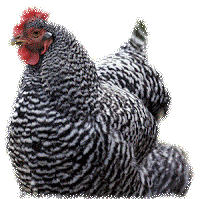 Barred Rock had their own beef over which had produced the ideal shaped egg for cascarones.
Barred Rock had their own beef over which had produced the ideal shaped egg for cascarones.
The Ameraucana cackled hers were inherently superior for two reasons. First, shape. Her tight oval and thick shell made cracking the end neat and easy. Second, color. The green shell requires no additional work to look  resplendent in the cascarones basket.
resplendent in the cascarones basket.
Buffy scoffed. “You don’t even know what ‘resplendent’ means. Beside, with my nearly uniform oval it makes no difference what end the cascaron maker chooses to open. And the soft pink makes coloring superfluous, but if dyed, gives a richness to the hue impossible with the brown shells of the Barreds.” The Barred Rocks protested in unison and loudly vigorously that productivity counted more than shape or color, and beside…
I gathered the daily take and left La Chickenada to their never-ending debate. Each made a good point, it is cascarones time and each blanquillo comes with its particular benefit. Blanquillo. My grandmother was teaching me about chickens and eggs when she pointed out that “huevo” is what little boys and men carry around and not to be confused with blanquillos, which is what hens produce.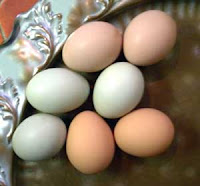
Easter Sunday is traditionally boiled egg gathering time. It’s also cascarones time. My flock keeps my refrigerator filled with blanquillos. It’s a simple process to crack open blanquillos and reserve them for the annual confetti fill. With Easter hard upon us, it’s still not too late to make up a supply. Plan a menu heavy with eggs--flan, custard pie, cheese soufflé, omelettes, and chiles rellenos—and in no time at all you’re ready to make a goodly supply of cascarones, if you dry the shells in a warm oven.
In honor of cascarones season, here are two recipes. First, cascarones. Second, gluten free chiles rellenos. 1. Gather your eggs. When you open a blanquillo, use the edge of a knife and crack the narrow end with sharp blows. Remove the end and pour out the whole egg, poach or cook que se salen. (That's my granma's word for "over medium". So this cook at a buffet in el Defie asks me how I want my egs, I say "que se salen" and he gives me a blank stare. "Over medium" I say in English, and he does so.) If you wish, poke a hole in one end first, then poke a hole in the other end. Blow out the contents and cook scrambled. Rinse the shell and let dry.
1. Gather your eggs. When you open a blanquillo, use the edge of a knife and crack the narrow end with sharp blows. Remove the end and pour out the whole egg, poach or cook que se salen. (That's my granma's word for "over medium". So this cook at a buffet in el Defie asks me how I want my egs, I say "que se salen" and he gives me a blank stare. "Over medium" I say in English, and he does so.) If you wish, poke a hole in one end first, then poke a hole in the other end. Blow out the contents and cook scrambled. Rinse the shell and let dry.
2. Use wax crayon to draw designs on the dried egg shell. Dye the shells and allow to dry thoroughly. You can dry them in the oven for an hour at 200 degrees. All year, I used to save the punchholes from a paper puncher. I also buy colored paper confetti at party stores. Do not use the plastic or aluminum confetti, unless you want to put out eyes.
3. When your spring fling arrives, crack cascarones on cocos. Careful in intercultural settings. When my kidlet was tiny she cracked one on her friend's head. The friend, being anglo, didn't understand the ritual and slugged my daughter.
4. Sweep up the mess.
People with gluten intolerance or worse, Celiac disease, cannot eat wheat, barley, or rye. Tortillas de harina. Out. Beer. Out. Cakes, cookies, pizza. Out, out, out of one's diet. Eating in restaurants becomes a serious problem, and fast-food joints are basically off-limits owing to contamination and the staff's lack of training on what's in their food and what "GF," gluten free, means. Peor, most analogs to wheat foods truly suck out loud. Gluten free beer is such a disappointment when one has enjoyed rich malty lagers and ales prior to discovering the condition. Lastima, you GF gente. Yo también.
But there's hope. Here, for example, is a completely successful rice-based batter for chiles rellenos. Over at Cook! Raza, I'll be including GF recipes like the one below.
GF chiles rellenos
-----------------------------------------
Fresh or frozen rajas de good chiles, or whole chiles. The ones in cans work, too.
GF flour or rice flour.
Fresh egg.
Milk.
Good melting cheese; jack, Oaxaca, mozzarella, cotija (very salty, not a great melter, so be careful). Cut into ½” rectangles the length of the chiles.
Chile powder, Gebhardt’s is an excellent commercial blend.
Baking soda. Salt.
Beat egg with milk. Add a pinch sal and two of baking soda.
Sprinkle flour over egg and whip to beat air into mixture. Make batter that slowly falls off a spoon.
Let sit for 10 or 15 minutes. (This is a key step using rice flour).
Dowse rajas/chiles in dry flour.
Stuff the chiles with cheese.
Dip floured chiles into batter. Let them sit, then dip again just prior to frying.
Heat good olive oil to smoking hot.
Slide stuffed battered chiles into oil. Use a spatula or perforated flat wok utensil.
Cook until fluffy and browned.
Turn and cook.
Remove from pan, place on newspaper or towels to absorb excess oil.
Serve with conventional side dishes. Cry in your GF bironga.
Happy St. Paddy's day yesterday. Comida de cuaresma time, so enjoy your nopales and tortas de camarron, and make up a bunch of chiles rellenos. Provecho!
Gente, La Bloga welcomes your comments and observations. We welcome, encourage, guest columnists. When someone posts a column you'd like to extend or respond to, leave a comment. If you've written something entirely different that you think fits La Bloga's emphasis on literature, arts and cultura chicana / latina, click here and let us know what you'd like to share.
See you next week with a review of Alicia Gaspar de Alba's Calligraphy of the Witch.
mvs

By: Kirsty,
on 8/9/2007
Blog:
OUPblog
(
Login to Add to MyJacketFlap)
JacketFlap tags:
UK,
god,
Religion,
Philosophy,
A-Featured,
A-Editor's Picks,
atheism,
baggini,
atheists,
atheist,
dogma,
dawkins,
good,
VSI,
Add a tag

By Kirsty OUP-UK
Today sees the start of another exciting new column for the OUP blog, inspired by our acclaimed series of Very Short Introductions. Every month I will be posing questions to a different author from the series about their topic and bringing you suggestions for more books to read on the subject, direct from the authors themselves. This month’s inaugural Q&A is with Julian Baggini, author of Atheism: A Very Short Introduction. He is the editor and co-founder of The Philosophers’ Magazine, as well as the author of a number of books including Making Sense: Philosophy Behind the Headlines (OUP), The Pig that Wants to be Eaten (Granta), and his latest book Welcome to Everytown: A Journey into the English Mind (Granta).
OUP: Is atheism just another religion for people to follow? (more…)
Share This
















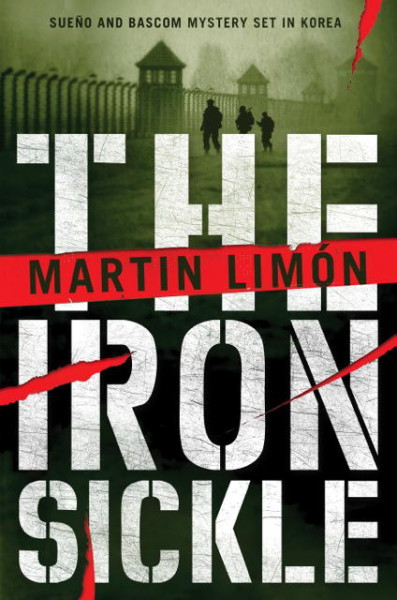




















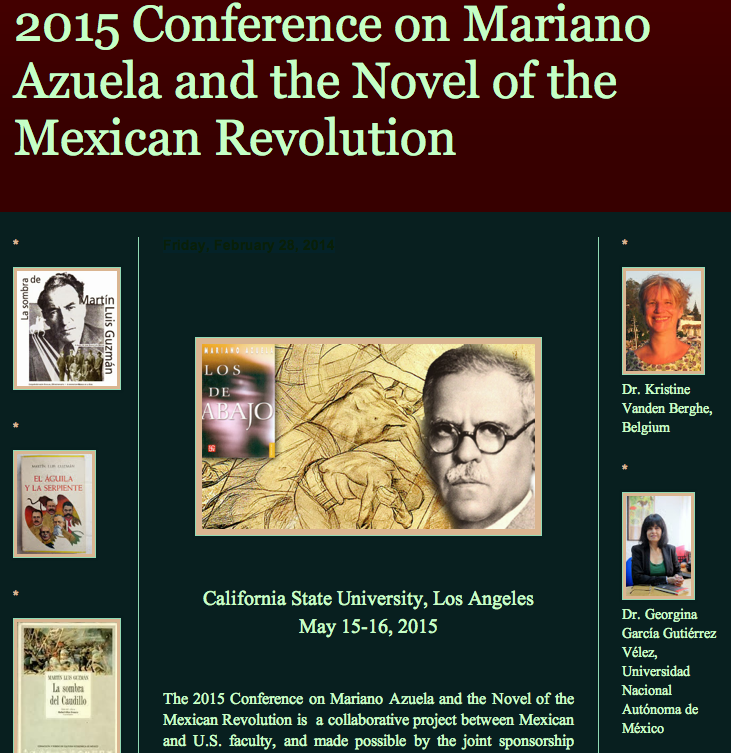



























































I made black bean burgers from a youtube demo and loved them. Never watch any of the shows – so sorry – I’m not help with that. Look forward to seeing your patchwork.
Yep, I’m a bean burger believer now. Patchwork coming soon…..